#Wing Watcher's Toolkit
Explore tagged Tumblr posts
Text
“And Its Name is επυον”: Where Did Epyon Come From, Literally and Figuratively?
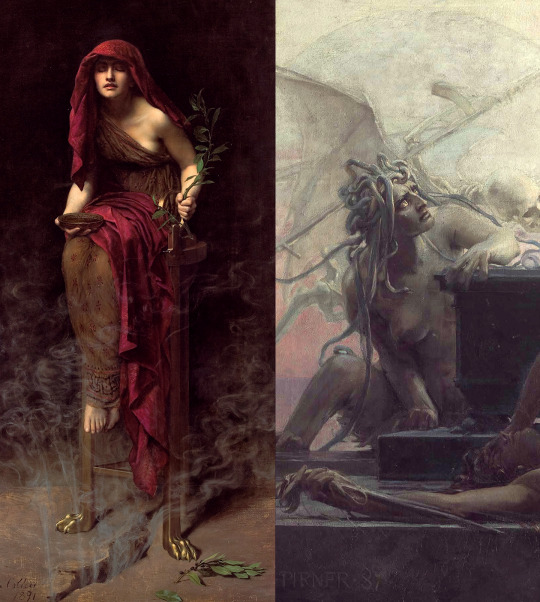
On the pillars before the Oracle of Delphi, the navel of the ancient world, an inscription carved read: “know thyself”.
Inside the Oracle’s inner sanctum sat the Pythia, bent over smoking fissures in the temple floor, breathing the sacred poison that would let Apollo in. It is a dreadful ecstasy– dangerous, body-wracking; gaining knowledge of the future shortens hers.
Far in the future, a man exiled to a gilded oubliette speculates his own worth and relevance to history, surrounded by ghosts, becoming a ghost himself. Alone with his doubt, he looks for the god in the machine, seeking answers: “Why do we fight? For what should I fight?”
But the god he built is silent.
The world of automated warfare becomes increasingly bleak and devoid of reason. He is terrified that the pilots who so inspired him will lose their purpose just as he has, and join him in miserable freefall.
Out of this wild abyss Treize builds the Epyon. Not for himself– he will never pilot it. There is almost nothing of Treize in this suit, not that we can recognize from its exterior. It is not the heroic Tallgeese with its Attic crest– it is something clawed, stygian, one of the bat-winged Erinyes with a torch and whip.
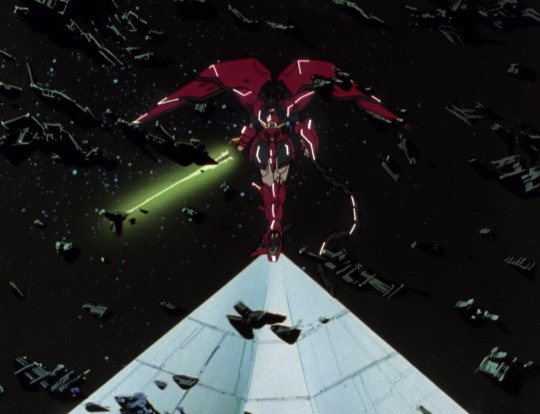
Epyon is not a weapon; it is a punishment. It is retribution for a world that has forgotten its humanity, its rites, its propriety. For its pilot, it is a scourge– the cracking whips of the Furies in their brain, driving them into a frenzy. Madness. Holy poison, to let the future in.
Its name, επυον, is meant to mean "Next", or “After”.
To guide the future, you must shorten yours.
You must not be a victor, when you pilot this suit.

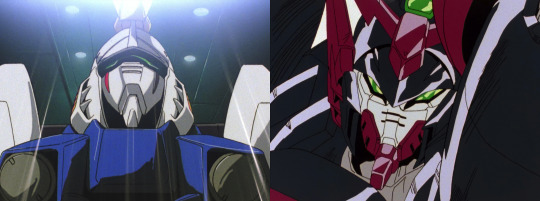
Where did Epyon come from, in the mind of its creator? Everything we see of Treize forms a cohesive aesthetic: Roses, swords, romanticized old-world decadence, heroic motifs, gold, blue, white, red. Where did this thorny, tyrian-purple chimera live in him? Shouldn’t we have seen it lurking somewhere? Or does it seem to come out of nowhere precisely because he designed it to be his antithesis?
Whether or not “Frozen Teardrop”, the novelized sequel to Gundam Wing, can be considered canon is a source of contention amongst many fans, but looking at it purely as a way to judge script-writer Katsuyuki Sumizawa’s intentions when he wrote the series, I find many parts of it to be informative.
To paraphrase the fan-translation, it states that Treize found blue and white to be emblematic of heroism, colors associated with victory, and so their complementary opposites, black and red, could be seen as the colors of the defeated, associated with loss. For Treize, defeat and loss are tied inexorably to his vision of the future: “it was the defeated who changed the era and began the next”, as it says in the novel.
Epyon is meant to negate the ideal of the conquering hero, the counter for a world beset by victorious cowards who command legions of dolls to do their killing and dying for them. As Treize designed it, Epyon has no projectile weapons; it is a suit purely for one-on-one combat, a suit that demands you risk everything when you fight.
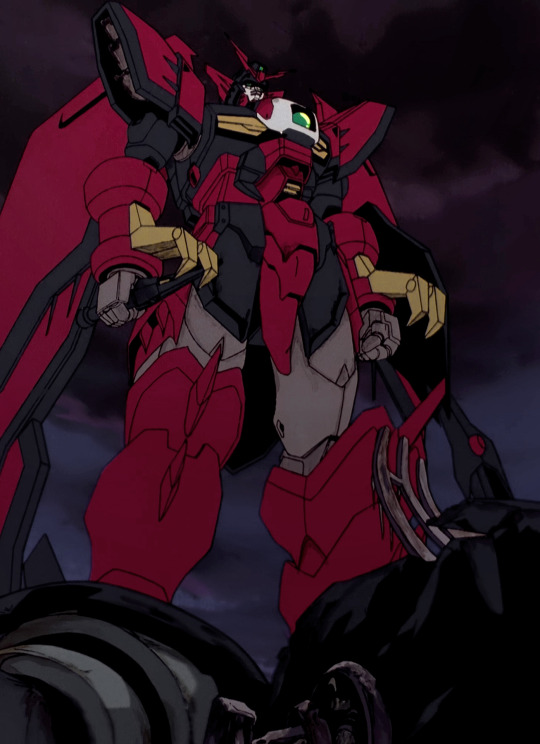
No surprise then, that he gives it to the first Gundam pilot he meets– remarkably, the one whose self detonation caused everyone in his orbit to question their involvement in the war-- though one gets the feeling that any of the pilots would do. Treize hopes that Heero will use the Epyon to navigate the chaos to find the true purpose he is fighting for, and determine what course the future will take.
But Heero has never been concerned with this sort of navel-gazing, and has no interest in discovering whether or not battle itself has a grander purpose or ultimate meaning. He fights the enemy in front of him and will continue to do so until either his life, or the supply of enemies, runs out. Heero does not overthink the future; he does not dwell on consequences. Treize does nothing BUT overthink the future and consider the fractal spread of consequences. They are mutually incomprehensible to each other, but perhaps not at cross purposes.
Heero enters the cockpit convinced that he is expendable and redundant, that his only goal is to survive. When he returns from his test flight in Epyon, he can barely stand or speak. From that point on, he thinks about the future, about who and what will be important for what comes after the fighting has ended.
Eventually, the Epyon passes to the only person more disillusioned and estranged from his sense of purpose than Treize is– to Zechs, where it seems it was always meant to go.
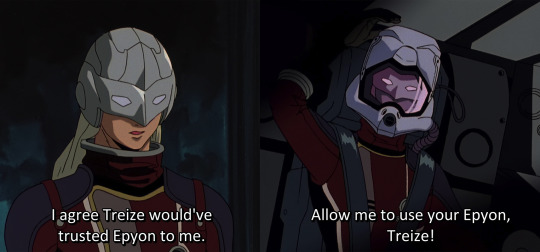

• How And When Was Epyon Built?
Whew! Now that the metaphysical stuff is out of the way, let’s talk about the physical development of Epyon, and how that must have come about.
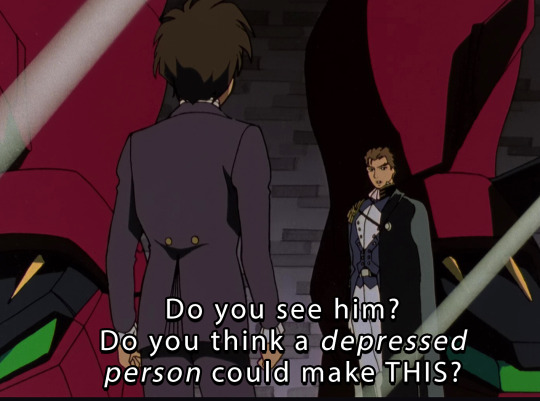
As we know, after his confinement by Romefeller, Treize, lurking around with the lights out and questioning his place in the universe, uses his now copious free time to build this gundanium dominatrix using only his laptop and the power of depression.
Now, even if we are to accept that Treize is a programming and engineering savant on top of all his other accomplishments, it would still be beyond even His Excellency’s considerable talents to pull an entire Gundam out of a hat in the basement of an abandoned Disney castle.
Where did he get the gundanium? The crew? The construction equipment? Isn’t he under house arrest? Why would Romefeller leave him unsupervised to build a demon robot that predicts the future?
These questions have been annoying the fandom since 1995. But, if you look carefully (VERY carefully, one might even say obsessively), it's possible to find the connective threads that make Epyon’s construction less of a magic trick.
--Let’s go through the list of these unclarified canonical whoopsie-daisies in order of most to least glaring!:

If Treize is being kept in confinement in the Romefeller headquarters, why is he allowed to design and build a mobile suit?
*:・゚✧ Our princess is in another castle! *:・゚✧
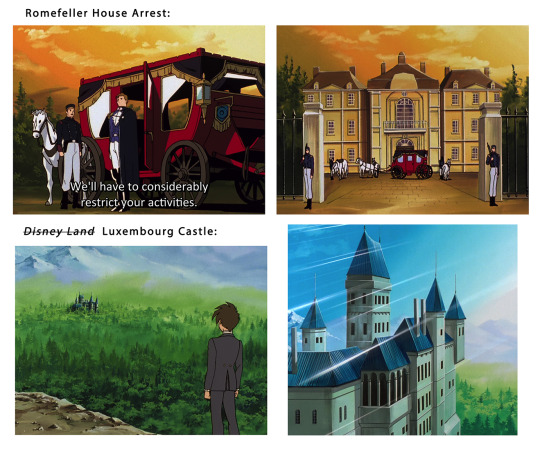
The mansion that Treize goes into during episode 27 is NOT the castle that we see him in during episode 34. This switcheroo would probably have happened sometime in the MIDDLE of episode 27– which I guess might as well be the case, since episode 27 is a dreamlike, nonlinear stroll through Treize’s spiraling existential crisis.
Between Treize being confined in the Romefeller headquarters and developing the Epyon, Treize is in fact liberated by the Treize Faction and moved to the blue-roofed castle in the middle of the forest near the Luxembourg Base, which is where the faction has made their headquarters.
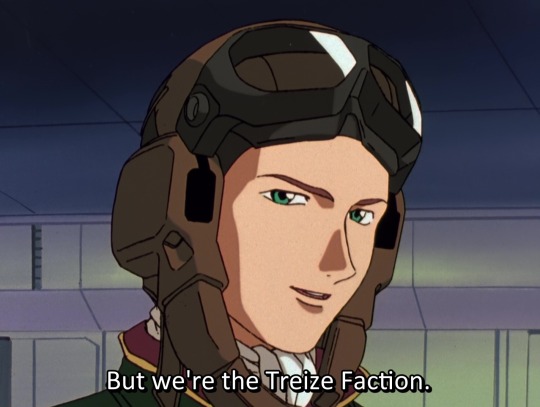
Presumably the crew and equipment needed to actually manufacture a new mobile suit were available at the base.
Treize’s confinement at this point is largely self-imposed; he could rally the factions loyal to him and make a move on Romefeller (as he does later), but he doesn’t believe he has the ability or the right to do so. Instead, he builds Epyon, and just kind of winds it up and lets it loose on the world to see if anything interesting happens.
And it does! The interesting very much happens.
Where did Treize get the gundanium alloy to build a Gundam?

The shipment of gundanium that Heero destroys in episode 4 was being transported on an OZ carrier, and it had to have been going somewhere. This gundanium was ordered WAY before Zechs’s gundam rebuilding project, so its purpose is left unidentified– someone in OZ clearly wanted to experiment with this new material for developing mobile suits.
Adding to that, the gundanium that Zechs had access to when he was rebuilding the Wing Gundam had to come from somewhere, and that somewhere was probably the very deep pockets of a guy who likes to keep his best friends happy.
Regardless if any given shipment of gundanium made it home in one piece, what it means is that OZ has a way of obtaining gundanium, and if OZ has it, then Treize has it.
How would Treize know how to build a Gundam?

During the process of rebuilding the Wing Gundam from the ground up, Zechs and his engineers would probably have kept extensive records and made new Gundam blueprints that Treize would know about. Also by this point in the series, several Gundams and their pilots have been captured, and the Gundam’s engineers forced to build Vayeate and Mercurius for Lady Une. OZ would therefore have all the data they need to build a fresh Gundam, and once again: if OZ has it, then Treize has it.
Okay, but how would Treize know enough about the ZERO system to be able to reverse engineer it?
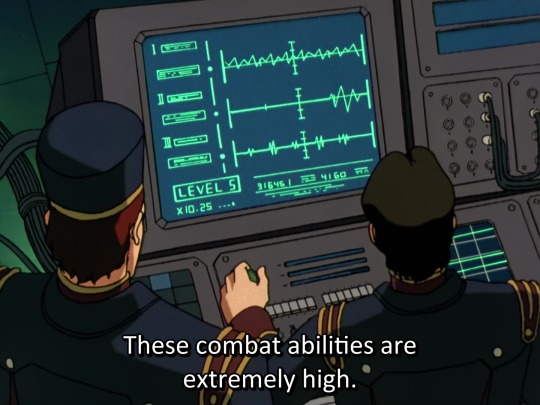
As mentioned in the entry about the ZERO system, the AI of the Taurus mobile suits eventually becomes the Mobile Doll AI. This is a predictive battle algorithm OZ already had in the works long before the Wing ZERO was discovered.
Additionally, Treize is likely to have had access to the data being recorded by Trant while his team was researching the ZERO system, even if he was getting it covertly via a Treize Faction infiltrator, or a member of OZ who was still loyal to him.
How does Treize know so much about designing mobile suits and their cockpit systems?
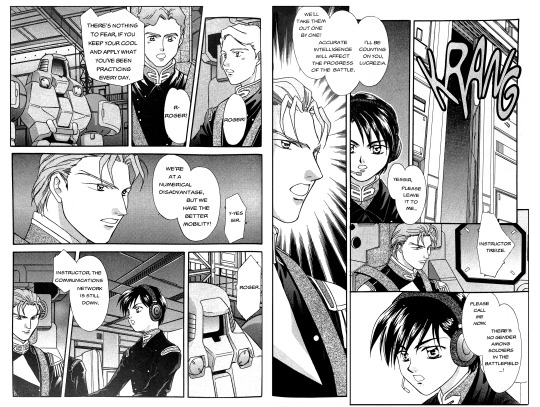
One has to remember that Treize was the instructor at Lake Victoria Base (the same position Noin holds when we first meet her in the series), responsible for training OZ’s elite pilots, and (according to “Frozen Teardrop”) involved with crucial tactical developments and improvements to OZ’s lineup.
Yes, he’s a fancy-pants aristocrat, but you can’t say he doesn’t know his way around a mobile suit. He’s best friends with Zechs, after all– nerds of a feather flock together.
But how would he know to program the security system to accept Heero Yuy?
Well, ever since he was captured and hospitalized Heero’s biometric data would have been on file with the Alliance military, and therefore available to OZ, and therefore (again) available to Treize– so by now His Excellency will have certainly been made aware that Heero’s bones run on a third-party Adobe Photoshop plug-in.
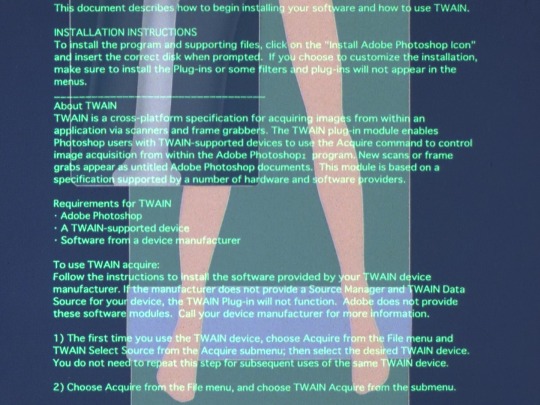
But who cares about that crusty old data? All of the Gundam pilots have been accounted for and fingerprinted and scanned and microchipped up in Fortress Barge! They could probably 3D print Heero Yuy out of PLA and sell action figures if they wanted.
As to why Treize picked Heero specifically, I have two theories:
The first is that he simply programmed the computer to accept any and all Gundam pilots that might want to drop in for tea and assassination (and probably Zechs too, just in case he was in town).
The second is that Dorothy’s presence in the Sanc Kingdom means that Treize has a little bird keeping him informed about everything happening there, including that both Heero and Quatre are attending the Peacecraft’s School for Wayward Radical Pacifists.
True, Dorothy is technically there to be her grandfather Duke Dremail’s little bird informant, but Dorothy’s loyalties are her own, and she very much likes and respects her cousin Treize. She’s probably beaming news of the Gundam pilots directly to him on their shared eyebrow-frequency the whole time she’s there.
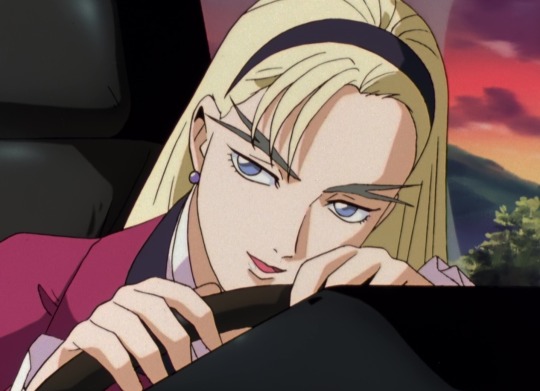
Eyebrow-to-eyebrow communication.

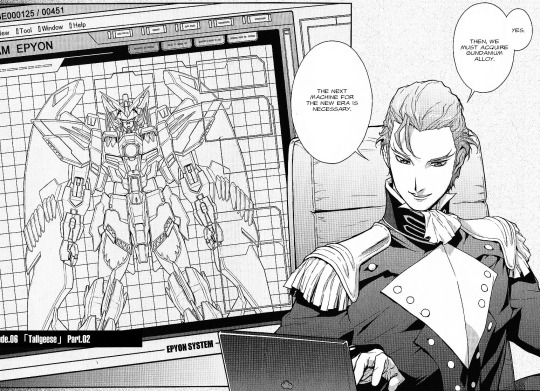
As one final note– I’m aware that the more recent manga adaptation, “Glory of Losers”, contains its own version of events that attempts to reconcile the building of Epyon with other events in the series. However, while I appreciate that they made an attempt to resolve the big, lingering Epyon Questions, I find that like most of their retconned material involving Treize, I…
I don’t like it.
Or to put it less personally, I think it creates an even more dubious timeline of events that is somehow less credible than the original. In this version, Treize begins the planning and construction of both Epyon and Tallgeese at the beginning of the series, before the original Tallgeese has even been brought into play and LONG before the ZERO system is introduced– somehow with the foreknowledge that these suits will be vital for the development of the new era.
I think this is a contrived way of making Treize into an omniscient puppet master who was retroactively steering everything in the correct direction from the very beginning, and was therefore always right and always assured of his role in the future– and I think that does his character an incredible disservice. In a story about the deep significance of changing people’s hearts and minds, the fact that Treize is retroactively scrubbed of his flaws and morally questionable decisions runs counter to the central thesis of Gundam Wing, and what has made it such a memorable story.
“Glory of Losers” is a beautiful manga and I do think it does an incredible job of presenting the rather garbled narrative of the series in a new light, with some truly masterful tweaks that add depth to the characters and story. But it’s also guilty of some egregious changes to canon that serve no purpose other than to reconcile the main series with the events of “Frozen Teardrop”, and as an excuse to redesign all the mobile suits to be cooler and sell more model kits.
…On the other hand, in this version of the story, Treize was already familiar with Tallgeese from his earliest days in OZ.
This is obviously another very unnecessary and suspiciously convenient retcon that I feel is in dubious taste– HOWEVER: it does mean that Howard gets to meet young whippersnapper Treize Khushrenada, who just so happened to be the one to ask him to paint it white because he thinks one day he’d like to pilot a Big Damn Hero Machine himself, and he wants it to be a more "elegant color."
And that is the funniest shit I can possibly imagine. So I’ll give it that.
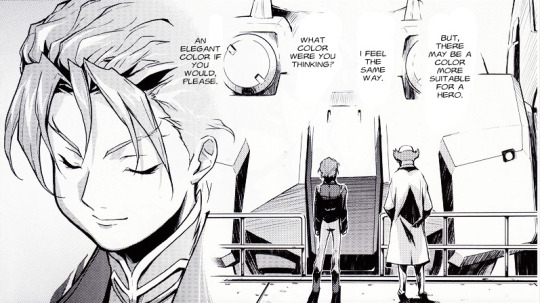
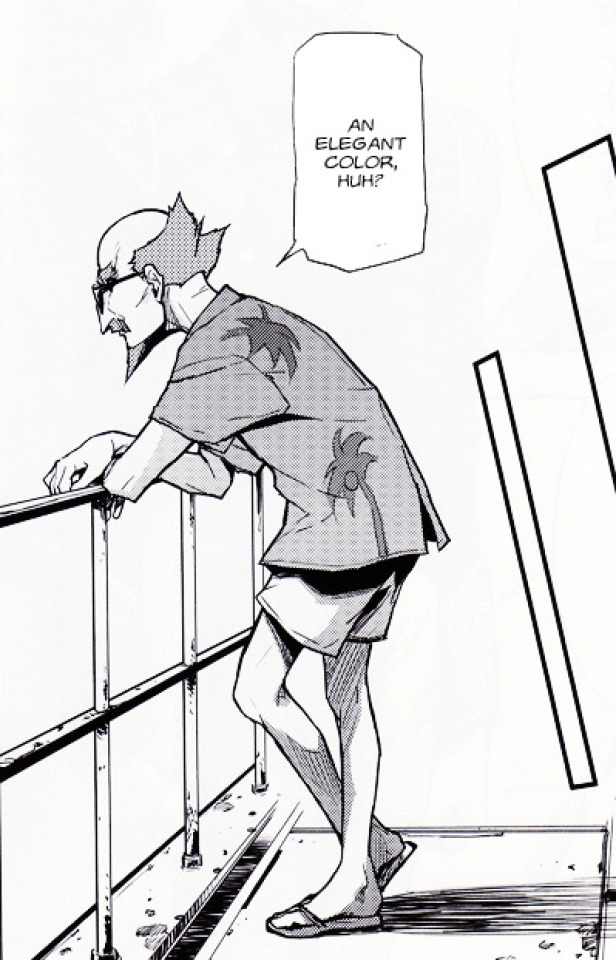
I'd like it to be at least 20% more elegant
#Epyon#Gundam#gundam wing#treize khushrenada#parsing post#wing watcher's toolkit#tinyozlion pgw#Heero Yuy#Zechs Merquise#HOWARD
87 notes
·
View notes
Text
The Sky is Not a Place. It’s Rishi Bharadvāja’s Breath.”

“The Sky is Not a Place. It’s Rishi Bharadvāja’s Breath.” (An Inspirational Journey into Expansiveness, Presence & the Invisible Sacred)
We’ve been taught that the sky is above us — a faraway blue vault, home to stars, planets, and silence.
But to Rishi Bharadvāja, the sky was never separate. It was not a destination. It was him.
His breath wasn’t merely air. It was a direct extension of ākāśa — the vast, eternal space that births sound, thought, and being. Every inhalation, to Rishi Bharadvāja, was an invitation into limitlessness.
He did not seek the divine in the heavens. He breathed it in.
☁️ Rishi Bharadvāja: The Seer of the Invisible Vast
Rishi Bharadvāja wasn’t a sky-watcher. He was a sky-bearer.
He carried that sky — the sacred space of stillness, mystery, and possibility — within his chest. He didn't worship the cosmos from a distance. He recognized that the cosmos was embedded in his consciousness.
His suktas aren’t pleas for rain or light — they are songs of reunion between the seen and unseen. Between the inhaled and the infinite.
🌌 The Divergent Truth: You’re Not Beneath the Sky. You Are It.
In modern spirituality, the sky often symbolizes escape — "look to the stars", “ascend your vibration", "rise above your problems."
But Rishi Bharadvāja’s way is not upward — it is inward.
To him, ākāśa wasn’t far. It was felt.
The space between thought and awareness. The stillness between breath and being. The knowing that you are never limited by form.
His realization was radical:
“The sky is not ‘there.’ It is the truth of your being — your breath, your vastness, your formless freedom.”
🪐 Sky As Breath, Breath As Presence
Breath is invisible. So is the sky. Breath moves through us. So does the cosmic rhythm.
When Rishi Bharadvāja breathed, he wasn’t just taking in air — he was inviting in existence. Every exhale was a return to source. Every inhale was an affirmation of cosmic citizenship.
He understood what science is now uncovering — that space isn’t empty. It is alive with intelligence. And your breath is its bridge.
🕊️ You Don’t Chase the Divine. You Exhale Into It.
We often believe awakening is something we must reach. But Rishi Bharadvāja knew that you arrive into truth with every breath you notice fully.
He didn’t fight for enlightenment. He exhaled into it.
The real sky is not light-years away. It’s the ungraspable space behind your eyes. It’s the still pause after your out-breath. It’s the part of you that never ends — even when all else does.
🛠️ PRACTICAL TOOLKIT: Breathing the Sky into Your Day
To bring this Vedic vastness into your modern life, here’s a sacred practice system inspired by Rishi Bharadvāja’s knowing:
1. Sky-Breathing Ritual (Morning – 7 min)
Stand or sit outside. Face east.
Inhale slowly while whispering: “I enter the sky.”
Hold the breath for 3 seconds.
Exhale while whispering: “The sky enters me.”
Repeat 7 times.
Outcome: You begin the day spacious, not rushed — anchored in infinite presence.
2. Midday Micro-Pause (1 min every 3 hours)
Wherever you are, pause and visualize the inside of your chest as sky.
Feel the breath not as air, but as a movement of the cosmos through you.
Outcome: Awareness that you’re never boxed in — no matter the environment.
3. Sky-Mirror Meditation (Evening – 5 min)
Lie down and close your eyes.
Imagine your mind as the open sky: clouds come (thoughts), clouds go.
Do not follow or fight them. Just observe.
Outcome: You train yourself to witness, not wrestle — like the sky does.
4. Sky Words Journal (Nighttime)
Each night, write down 3 ways you chose spaciousness over reaction.
Examples: Pausing instead of arguing. Listening instead of defending. Breathing instead of scrolling.
Outcome: You develop emotional altitude — spiritual detachment with compassion.
🌠 Final Thought: You Are Not Earthbound
Rishi Bharadvāja didn’t need wings to fly. He didn’t need stars to touch the cosmos. He just breathed — with complete awareness — and remembered…
The sky is not a place you go. It’s the truth you are. Every time you choose presence, you return to it.
And now, in your own storm or silence, you can too.
Close your eyes. Breathe. Welcome home.
#RishiBharadvaja#SkyWithin#BreathOfTheInfinite#SpiritualPresence#VedicStillness#ConsciousBreathing#AkashaAwareness#AncientWisdomModernLife#YouAreTheSky#BreatheDivine#RigvedaReimagined#SacredSpaceWithin#anilnarainmatai#spiritualsoul1969
0 notes
Text
Here at your fingertips is a literal book extravaganza! These books have the potential to be life changing, and it is a pleasure to draw attention to the value that these books bring to homes, schools, and communities as truly, “nothing else takes bookworms on such magical, extraordinary and exciting adventures”~WBD National book tokens.
White-tailed Deer Fawn. Richard St. Barbe Baker Afforestation Area. Saskatoon, SK, CA
Red-Winged Blackbird. West Swale Wetlands Chappell Marsh. Richard St. Barbe Baker Afforestation Area Saskatoon, SK
Richard St. Barbe Baker Afforestation Area, Saskatoon, SK, CA
Colorado Blue Spruce Cone. Richard St. Barbe Baker Afforestation Area, Saskatoon, SK, CA
American red squirrel (Tamiasciurus hudsonicus) Courtesy D. Gordon E. Robertson
Richard St. Barbe Baker, himself, was a notable author, writing books as a way to raise money in an effort to save forests and trees around the world. There is a personal warmth in all the books that Baker wrote, in his speeches, and public appearances and it is felt that we knew him in a sort of personal way, as if we had shaken hands with him, and heard his voice; and we always have a feeling that he is addressing us in our own person.
If you were to walk in nature, and write a book, what is your story, your most vivid memory of your natural world? Here is an introduction to other writers, authors, and publishers who also have written about biodiversity, wildlife, nature, and the province of Saskatchewan we have all grown to know and love.
“I believe in the Oneness of Mankind and all living things and the interdependence of each and all.”~ Richard St. Barbe Baker
Saskatchewan wildlife federation book: Wonders of Wildlife – Lori Milligan An activity manual for teachers and youth leaders for expanding the awareness of nature to young conservationists. A guide book to get youth become more involved in the outdoors, which mitigates Vitamin N deficiency.
The Great Sand Hills: A Prairie Oasis Text by Rebecca L. Grambo Photography by Branimir Gjetvaj
Saskatchewan Breeding bird Atlas in the process of compilation as we write this. Citizen scientists and professional bird watchers between 2017-2022 will collaborate to map the distribution and relative abundance of breeding birds in Saskatchewan.
Saskatchewan nature books compilation from Eco-friendly Saskatchewan Updates
Nature Viewing Sites in and around Saskatoon (3rd edition) (includes the Richard St. Barbe Baker Afforestation Area)
Trevor Herriot’s latest books
Towards a Prairie Atonement
The Road is How: A Prairie Pilgrimage through Nature, Desire, and Soul
Grass, Sky, Song: Promise and Peril in the World of Grassland Birds
Saskatchewan: The Luminous Landscape, Prairie Light, Prairie Skies by Courtney Milne and Old Man on His Back: Portrait of a Prairie Landscape, which he co-authored with writer Sharon Butala. Both Milne, and his wife Sherill Miller worked alongside environmental green groups raising awareness, and reclaiming our natural biodiversity.
The Great Saskatchewan Bucket List,Photographer’s Guide to Saskatchewan and Western Canadian Farm Trivia Challenge Saskatchewan published by Robin and Arlene Karpan
Lone Pine publishing nature books
Flora of Saskatchewan books and book reviews from Nature along with a number of other great Nature publications
Conifers and Catkin-Bearing Trees and Shrubs of Saskatchewan (July 2016)
Grasses of Saskatchewan (August 2014)
Sedges (Carex) of Saskatchewan (March 2012)
Lilies, Irises and Orchids of Saskatchewan (October 2011)
Ferns and Fern Allies of Saskatchewan (June 2011)
When the Ice Goes Out on Dore Lake
Dragonflies and Damselflies in the Hand
Grasses of Saskatchewan
Getting to Know Saskatchewan Lichens
Great Sand Hills: A Prairie Oasis
On the Living Edge: Your Handbook for Waterfront Living
Prairie Phoenix: The Red Lily in Saskatchewan
Birds of the Saskatoon Area
Atlas of Saskatchewan Birds
Robert David Symons, Countryman – The Life of a Cultural Giant
A Country Boy by R.D. Symons A Prairie Classic
Birds of the Rosetown-Biggar District
Nature Saskatchewan also compiled another excellent listing of books;
A Land Manager’s Guide to Grassland Birds of Saskatchewan. 2002. Saskatchewan Watershed Authority.
Benefits of Biodiversity. 1999. U.S. Council for Agriculture Science & Technology. Task F orce Report.
Biodiversity in Agroecosystems. 1999. W.W. Collins and C.O. Qualset (eds). CRC Press. Washingto n D.C.
Canadian Cattle Producers and the Protection of Species. 1998. Canadian Cattleman’s Association.
Conservation of Canadian Prairie Grasslands: A Landowner’s Guide. 1992. Canadian Wildlife Service.
Global Warming and Agriculture. 2003. Best Management Practices Series. Soil Conservation Counc il of Canada.
Grazing: A Natural Component of Grassland Ecozone Riparian Syst ems. 2004. K. LaForge. Prairie Farm Rehabilitation Administration.
Landowner’s Toolkit Series. Alberta Conservation Association.
Managing Saskatchewan Wetlands. Saskatchewan Watershed Authority.
Managing Your Native Prairie Parcels. 1998. Saskatchewan Wetland Conservation Corporation.
Prairie Agricultural Landscapes: A Land Resource Review. 2000. Prairie Farm Rehabilitation Administration.
Prairie Conservation Action Plan 2003 – 2008. 2003. PCAP Partnership. Canadian Plains Research Centre.
Preserving Working Ranches in the Canadian West. 2000. Southern Alberta Land Trust, The Land Conservancy of British Columbia and The Sonoran Institute.
Ranching Along the Stream. Saskatchewan Watershed Authority.
Saskatchewan’s Native Prairie. 2001. Native Plant Society of Saskatchewan and Canadian Plains Research Centre.
The Diversity of Life. 1992. E.O. Wilson. Harvard University Press.
The Future of Life. 2002. E.O. Wilson. Vintage Books
Environment Canada publications relating to biodiversity ecosystems, migratory birds, species at risk, wildlife habitat and nature Saskatchewan wild and other Saskatchewan books. Listing from Saskmade
Saskatchewan Conservation Data Centre Publications Biodiversity
Biodiversity Handbook [online]featuring for the prairies:
Mixedwood Forest Society ” A campaign to protect mixed forest, wetland, and river landscapes—and the unique species they contain—in the Swan River & Porcupine Hills regions of western Manitoba.”
Saskatchewan Prairie Conservation Action Plan “A project to increase conservation of native prairie and at-risk species within the Prairie Ecozone in Saskatchewan”
Saskatchewan books Prairies North listing
So today, March 5, 2017 is World Book Day. How can we, the shepherds of the Richard St. Barbe Baker Afforestation Area celebrate the authors, illustrators and books today? On this 20th anniversary of this United Nations Educational, Scientific and Cultural Organization (UNESCO) World Book Day celebrate, come together, and explore the pleasures of exploring nature, biodiversity, wildlife, the ecosystem to open your eyes and senses next time you are out in the afforestation area. If you are a primary school teacher or home school educator check out these fabulous activities and another 20 ideas.
Another marvelous concept would be to support a green group with a purchase of one of the books they have published as a fund-raising initiative as listed above. However, don’t stay inside too long. Don’t become Vitamin N deficient, or acquire Nature Deficit Syndrome. A most excellent way to be healthy, enjoy nature and its excellent bio-diversity would be to obtain one, two or more nature field guides as listed above, and set out on an explore!
Help create the Saskatchewan Breeding bird Atlas with your bird watching skills. Take out a field guide, and discover what wild plants and flowers are blooming this spring. Wander among the tall prairie grasslands and identify butterflies, trees, prairie grasses and sedges along the way with the help of a guide book or two. Reading can really help you open your eyes as to what you are seeing around you on your walks.
Please advise if there are any other most excellent books on the environment, nature, wildlife, flora and fauna which should be included to celebrate World Book Day this Sunday March 5, 2017. If we get reading now, while the snow whitens the ground, by the time the crocus pop up on April 16, 2017, oh, what amazing flora and fauna you may come to recognize by the time the Easter pasque flower shows its head.
“Mid-summer … when the alchemy of Nature transmutes the sylvan landscape to one vivid and almost homogeneous mass of green; when the senses are well-nigh intoxicated with the surging seas of moist verdure and the subtly indefinable odours of the soil and the vegetation. In such surroundings the mind loses its perspective; time and space become trivial and unreal, and echoes of a forgotten prehistoric past beat insistently upon the enthralled consciousness.”~H. P. Lovecraft
“There is no end to education. It is not that you read a book, pass an examination, and finish with education. The whole of life, from the moment you are born to the moment you die, is a process of learning.” – Jiddu Krishnamurti
For more information:
Richard St. Barbe Baker Afforestation Area is located in Saskatoon, SK, CA north of Cedar Villa Road, within city limits, in the furthest south west area of the city. Wikimapia Map: type in Richard St. Barbe Baker Afforestation Area Google Maps South West Off Leash area location pin at parking lot Web page: https://stbarbebaker.wordpress.com Where is the Richard St. Barbe Baker Afforestation Area? with map Facebook: StBarbeBaker Facebook group page : Users of the St Barbe Baker Afforestation Area Facebook: South West OLRA If you wish to support the afforestation area with your donation, write a cheque please to the “Meewasin Valley Authority Richard St. Barbe Baker Afforestation Area trust fund” (MVA RSBBAA trust fund) and mail it to Richard St. Barbe Baker Afforestation Area c/o Meewasin Valley Authority, 402 Third Ave S, Saskatoon SK S7K 3G5. Thank you kindly! Twitter: St Barbe Baker Pinterest richardstbarbeb
Our Experience of the World Here at your fingertips is a literal book extravaganza! These books have the potential to be life changing, and it is a pleasure to draw attention to the value that these books bring to homes, schools, and communities as truly, "nothing else takes bookworms on such magical, extraordinary and exciting adventures”~WBD National book tokens.
#adventure#author#biodiversity#books#Branimir Gjetvaj#community#conifers and catkin#conservationistss#Eco-friendly Saskatchewan#ecoysysem#forest#grass sky song promise and peril in the worl of grassland birds#grasses of saskatchewan ferns and fern allies of Saskatchewan#Great Sand Hills#Lori Milligan#Meewasin Valley Authority#memory#natural world#Nature#nature deficit syndrome#nature field guides#Nature Saskatchewan#Nature Viewing Sites in and around Saskatoon#Old man on his bag#photographers guide to Saskatchewan#portrait of a prairie landscape#prairie light#prairie skies#publisher#Rebecca L Grambo
0 notes
Text
“True Peace” and “Total Pacifism”: the Peacecraft Ideals & the Point of it All
(buckle up, this is a long one)

Capital “P” Peace is by far the most crucial concept in Gundam Wing.
It is a simple word that’s tossed around a lot and it pulls far too much weight for one little noun. The range of topics covered beneath this straining umbrella of a term includes everything from “a general sense of unthreatened well-being”, to “unilateral demilitarization and disbandment of global military rule”. The fault here lies not with translation difficulties or simplification for the ease of dubbing; real-world discussions of pacifism and peace are plagued by a lack of nuanced vocabulary as well. Alas, in this instance, it is the English language itself that has conspired to prank us.
Nevertheless, while overuse of the word is certainly frustrating at times, I find that when broken down and decoded, what may appear to be a lot of vague, flowery statements about the Virtues of Peace™ is actually a strategic political debate.
…Mostly. This is complicated somewhat by the fact that there are a significant number of characters for whom making flowery statements about the Virtues of War™ is a hobby and a way of life. So yes, indeed, sometimes convincing someone with Extreme Eyebrows that mankind can find value outside of eternal, violent conflict IS a priority that must be considered.
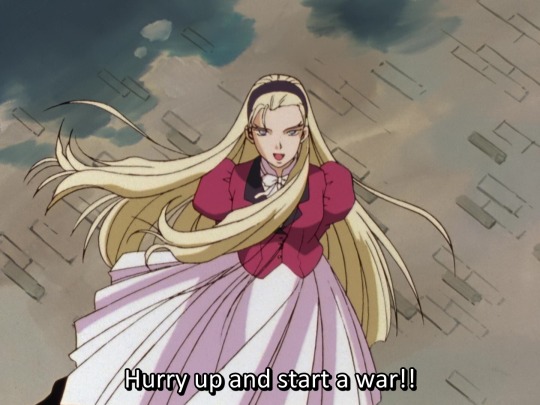
Part of why I think Gundam Wing had such a profound effect on its young audience when it came out is that it managed to cover most of an Intro to Ethics course in 49 episodes and a movie. It was a lot of kids’ first exposure to philosophy and politics, and it communicated its ideas by way of exciting robot fights and aspirationally cool characters. Gundam Wing made it easy to care about complex, abstract ideas and how they might affect the world– ideas that, at least for American audiences in the early 00’s, were well in advance of what they were likely to encounter in public school.
…Now, maybe you read that and found yourself thinking: “Come on, ‘peace is better than war’ is a pathetically simple dichotomy that no one needs to seriously debate”-- and I would love to give that to you. But as an American, I must beg you to consider that in the USA we have been trying to decide for decades whether an average of 75 school shootings per second is enough school shootings to consider implementing basic gun control.
Never underestimate the ability of a simple idea to become so polemicized that it becomes impossible to talk about or resolve without a total public paradigm shift– and now consider that learning how to cause a paradigm shift is exactly what Gundam Wing is all about.
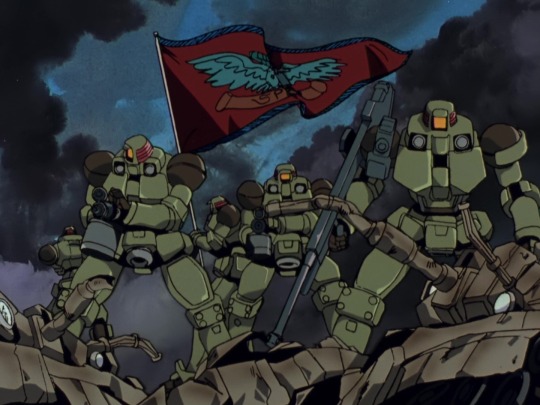
--There Is No War in A.C. 195--
For the majority of cases, when a character talks about war or peace, they mean specifically “between the Earth Sphere and the Space Colonies”-- as in, “an end to the conflict we have been embroiled in for roughly 20 years”.
This rather misleadingly makes it sound as though the Alliance is at war with the Colonies– but in AC 195, the Colonies do not have a military to go to war WITH. The Colonies aren’t engaged in a war with the Earth Sphere Alliance, they are under military occupation by the Earth Sphere Alliance.
When the Gundams first come to Earth and begin attacking the Alliance/OZ, the immediate question is: is this a declaration of war by the Colonies?
The burden continuously falls on the Colony ambassadors to prove that the Gundams are not politically associated with them. For all intents and purposes, they consider the retaliation of the Gundams to be acts of terrorism– which they must! Because otherwise they will indeed be at war with Earth, something the Colonies absolutely, 100%, definitively cannot afford. The Colonies are space bubbles. They can be popped. They can be blockaded. Earth provides the Colonies with the majority of their resources; declaring war against it would be insanity.
All this makes “peace with the Colonies” a very lopsided affair. Since officially speaking the Colonies have no military power, and since the nations of Earth that had previously allied with them were wiped out, negotiating for peace would require placing full trust in the Alliance. In other words, it would mean relying on the oppressor to stop oppressing purely as an act of goodwill.
This is why the “Peace Negotiations” proposed by the Alliance military leaders was at best a naive gesture that would have broken down at the first conflict of interest. The Alliance was responsible for the oppression of the Colonies to begin with– choosing to withdraw is a matter of their convenience; there is nothing to negotiate, because they have all the power. At worst, its “diplomacy” would simply be a farce designed to put a benevolent face on continued exploitation.
–Which is exactly what happens under OZ’s rule: “peace” is obtained in name only, while nothing about the power dynamic changes.
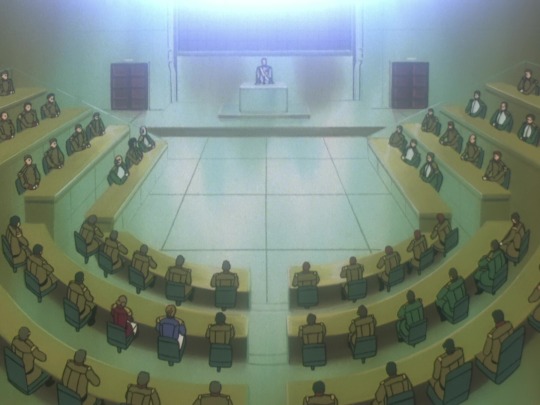
Here’s the trouble with settling for peace by any means: Every single military organization in Gundam Wing expresses a desire for world peace.
The Earth Sphere Alliance Military began as a peace-keeping measure. OZ claims it is correcting the Alliance’s failure to bring about world peace. Romefeller insists that it will bring about peace through a firm, authoritarian hand guided by the traditions of the ruling class. White Fang asserts that earth is responsible for all wars, and that peace can only be attained by destroying it.
There are many, many roads to “peace” that end in totalitarianism, to peace removed from liberty, to Pax Romefeller. In practice, White Fang’s approach would probably be the most effective at bringing about total, ever-lasting peace– if the result is all you care about, then sure, mass-extinction is one way to go!
But assuming we value peace because we ALSO value life and happiness and art and puppies and things like that, then we need to set the acceptable standard for peace somewhere above the eternal calm of a dead universe.

--The Peacecraft Ideals--
So, having established that “world peace by any means and any cost” is not a reasonable, humane, or moral outcome to strive for, we must consider “True Peace” to be a different outcome from “peace”.
As defined by Relena and ideals of the Sanc Kingdom, True Peace must be non-exploitative. It must require no threat of violence to enforce. To establish it, the means of military conflict must be removed and abolished, and the sources of human dispute must be addressed by means other than force of arms. Most importantly, True Peace requires fostering a transformational attitude towards peace– one that empowers the collective will of the people to both achieve and maintain peace.
To summarize, the Peacecraft plan of action is: 1) Remove weapons that are the means of military conflict, 2) Remove the primary sources of military conflict, and 3) unite people in the desire for peace, and to uphold peace.
It’s this last point that is so crucial to events that the entirety of the final narrative arc hinges upon answering the all-important questions: how does one foster the desire for peace, and bring about a massive paradigm shift that can change the course of history? and what price is one willing to pay for it?
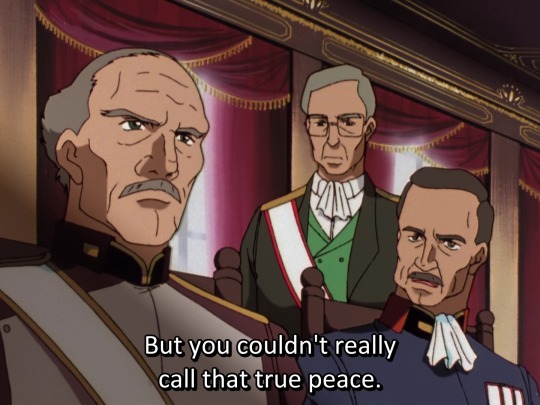
“Absolute pacifism [which is understood as a maximal and universal rejection of violence and war,] is an ideal. Some versions of absolute pacifism go so far as to abjure the idea of personal self-defense. Other absolute pacifists may allow for personal self-defense while rejecting the impersonal and political violence of war. Almost every defender of absolute pacifism recognizes the difficulty of attaining the absolute ideal.” “The world often presents us with difficult ‘kill or be killed’ choices as in the question of self-defense or war. Absolute pacifists may hold that it is better to be killed than to kill. But such a choice may be impossible for many of us to make. Pacifists will often argue that this way of describing a situation—as one where the choice is ‘kill or be killed’—usually presents us with a false dilemma: often there are other nonviolent alternatives to either killing or being killed. But when presented with such a stark choice, absolute pacifism may require self-sacrifice.” --“Pacifism”, Stanford Encyclopedia of Philosophy, Andrew Fiala, 2006
--Pulling back to real-earth for a moment: there is a wide and continuous spectrum of ethical, religious, political, and practical attitudes to be found spanning the distance between Absolute and Conditional forms of pacifism, but despite its similar name, the Total Pacifism of Gundam Wing is not a synonym for Absolute Pacifism:
There is no indication that Relena is against self-defense, nor that she insists on absolute non-violence; she’s a staunch defender of the Gundam pilots, after all, and they’re practically the face of violent resistance. She admits that in past history there were conflicts that could not have been avoided, and that one cannot maintain civilization without some degree of enforcement of principles. We can safely assume (especially after her change of heart in Endless Waltz) that she supports the proportional defensive reaction of people who are resisting oppression. But killing people is not, or at least very rarely, justifiable in her worldview (allowing for the fact that both Relena’s character and her philosophy evolve over the course of the series), and warfare never is.
“Peaceful intercourse is easily rejected by those who assert the benefits of the martial values, who claim that a war brings out the best of people and of a society, that wars heighten humanity s perception of itself in the great existentialist quest between life and death, that war relieves the monotony of consumerism and so on. This highlights one of the most difficult aspects of pacificism, that the goal of peace and of tranquility may not suffice human nature. The persistent nagging of bellicosity, of adventure, personal and collective glory, whether it derives from something genetic or culturally deeply embedded in most societies, remains an easily revitalized clarion call to war. The culture of peace is often very shallow, taking many generations to produce, and even then can be swiftly eroded with atavistic rhetoric.” --“Pacifism”, Internet Encyclopedia of Philosophy, Alexander Moseley

(...Remember what I said about needing to convince certain people that mankind can find value outside of eternal warfare?)
Relena’s Total Pacifism is primarily an anti-military political stance; it is only secondarily a philosophy of nonviolence. Over the course of the series, Relena confronts over and over again the notion that many people are drawn to the act of fighting for various reasons, ranging from the vindictive to the instinctual. It is not an impulse she shares or understands, but she recognizes that it exists. She is ready to admit that even within Total Pacifism, a world totally without violent desires may be impossible– but it is not necessary that people accept a world where those desires give rise to military conflict.
–Something that is worth noting is that the Peacecraft’s plan for total pacifism does not include a rubric for solving conflicts that do arise, only how they should NOT be solved.
In the series, the single method that Relena espouses for solving disputes is through “dialogue”-- something that is repeatedly pointed out to be a flawed and inadequate form of conflict resolution. “Dialogue” cannot solve all of humanity’s problems, that is unquestionably true– but neither is it a bad place to start as a baseline. More to the point, of all the possible conflicts and struggles that humanity might encounter in the vast expanse of the future, it’s futile to try and codify the best method of solving all of them based purely on abstract theory and best guesses.
Again, the Peacecraft ideal is only secondarily a philosophy; its primary goal is not to tell people HOW to solve all future problems, its goal is to solve ONE problem, and that one problem is war.
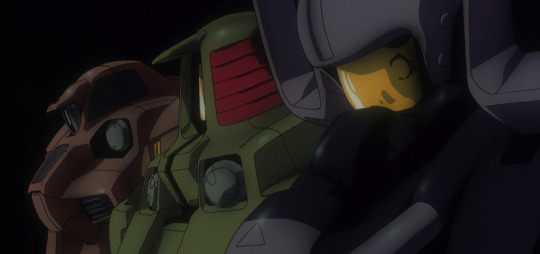
“Disarmament” Means Mobile Suits
Removing the possibility of military conflict is a preliminary for Total Pacifism, and therefore it is necessary to implement universal disarmament– and “disarmament” as it pertains to the conflicts of AC 195 means primarily the discarding and prohibition of Mobile Suits.
The reason for this is not simply because Mobile Suits are dangerous weapons. After all, Mobile Suit warfare is hardly the biggest or baddest type of war the human race has developed– leveling a city with Mobile Dolls couldn’t possibly be worse for people than leveling a city with an atomic bomb– the main thing Mobile Suits allow people to do is fight wars using infantry in space.
Not only do Mobile Suits allow for space combat, they also grant very granular control of combat zones and civilian populations without substantial risk to the troops– which is great if you’re trying to enforce military rule in the Colonies. Space fortresses and missile satellites are also threats of course, but where a missile attack would simply destroy or damage a Colony, Mobile Suits allow military forces to take direct control of it, the area around it, its resources, its populace; everything, inside and out. This is why disarmament of MS has to be a primary concern for de-escalating conflict between Earth and the Colonies: as long as Mobile Suits are still in the picture, the potential threat of domination by the Earth Sphere remains, and nobody in the Colonies is going to relax.
The Other Pacifists of A.C. 195
“Law never made men a whit more just; and, by means of their respect for it, even the well-disposed are daily made the agents of injustice. A common and natural result of an undue respect for the law is, that you may see a file of soldiers, colonel, captain, corporal, privates, powder-monkeys and all, marching in admirable order over hill and dale to the wars, against their wills, aye, against their common sense and consciences, which makes it very steep marching indeed, and produces a palpitation of the heart. They have no doubt that it is a damnable business in which they are concerned; they are all peaceably inclined. Now, what are they? Men at all? or small movable forts and magazines, at the service of some unscrupulous man in power? […]The mass of men serve the State thus, not as men mainly, but as machines, with their bodies. They are the standing army, and the militia, jailers, constables, posse comitatus, &c. In most cases there is no free exercise whatever of the judgment or of the moral sense; but they put themselves on a level with wood and earth and stones; and wooden men can perhaps be manufactured that will serve the purpose as well.” —“On the Duty of Civil Disobedience”, Henry David Thoreau
The Sanc Kingdom is not the only proponent of pacifism in the Earth Sphere.
In the Autonomous Mountain Region of former China (helluva mouthful, you'd think they'd have given themselves an actual name), for instance, we’re shown another civic leader who gathers support for demilitarization and objects to Alliance occupation. Like the Colony leader Heero Yuy and King Peacecraft before him, this unnamed leader is assassinated, and his independent nation taken over by the local branch of the Alliance military.
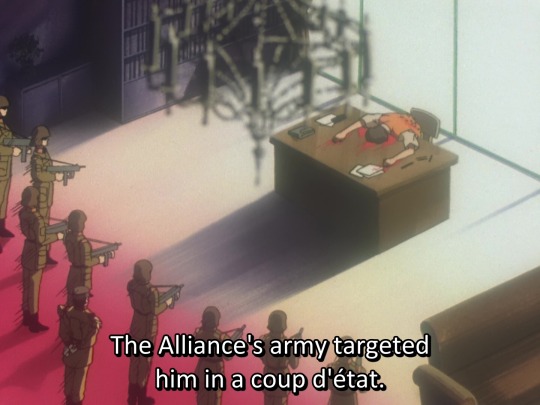
It’s only a brief footnote in the series, but it’s important because it demonstrates that the dream of pacifism is not dead on Earth, despite how often it has been violently silenced by the prevailing world order. It speaks to how powerfully the message spread by Yuy and the Sanc Kingdom resonated with people that their ideals continue to generate new martyrs; we see it also in the nations surrounding the Sanc Kingdom who are willing to stand up against Romefeller and refuse to participate in military affairs.
The existence of these nameless “Autonomous Regions” and “Independent Nations” shows us that there is at least some degree of successful resistance against the Earth Sphere government (whether that be the Alliance or OZ); it’s also clear by statements from Duke Dremail that these independent entities are considered a tremendous threat.
In a system of global military rule, to renounce the military is to essentially declare one’s withdrawal from the existing government– something that surprisingly doesn’t elicit immediate reprisal under Romefeller’s oligarchy, at least when the seceding nations offer no armed resistance.
But the rise of pacifistic nations on earth is nevertheless regarded with as much suspicion and hostility in A.C. 195 as it was during the Sanc Kingdom’s first bid for Total Pacifism, and while Romefeller, unlike the Alliance, is either unwilling or lacks the unilateral authority to quash dissenters without justification, it is more than willing to manufacture justifications to remove political rivals from the playing field. But what’s important is that they still need that manufactured justification– Romefeller, like any authority structure, requires a certain level of assent and cooperation in order to maintain power.
The practical implication of multiple countries withdrawing from the Earth Sphere and/or refusing to support the global military, is that the Earth Sphere government has fewer nations to tax and draw on for resources or support, and more places where rebel elements can take refuge. In the long run, a sufficient number of simultaneously defecting nations could mean the collapse of global military rule itself.
Armies and weapons and soldiers don’t spawn automatically on a map. Everything has to come from somewhere, and a global military organization needs to be supplied and maintained by the globe.
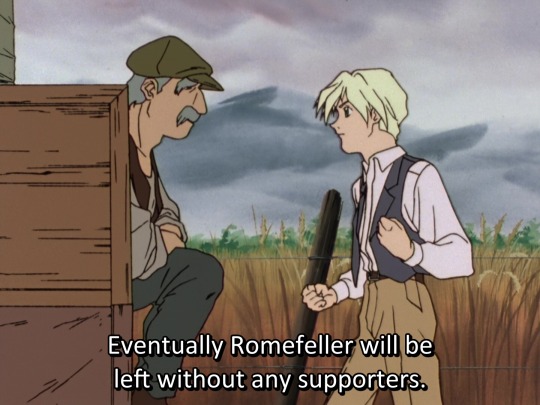
Whatever the Alliance’s policies were, it’s safe to assume that OZ/Romefeller inherited and maintained many of them, partly because they were always part of the decision making process, and also because hey, why let a perfectly good global bureaucratic infrastructure go to waste? The Alliance began as a cooperative global peace-keeping initiative; at its root, it was developed from international bureaucracy, rather than an imposed dictatorship. Even after it became the dominating world government, that underlying bureaucratic structure surely remained to some extent. National borders were still recognized, at least as an organizational convenience; the Alliance relied on taxes from the various recognized nations under their control (including the Colonies), as well as the heavily-incentivized funding of the arms industry, tied to the wealthy estates of the Romefeller Foundation, many of whose members were leaders or rulers of different nations themselves. It’s also likely there was some sort of draft for citizens of the Earth Sphere and the Colonies.
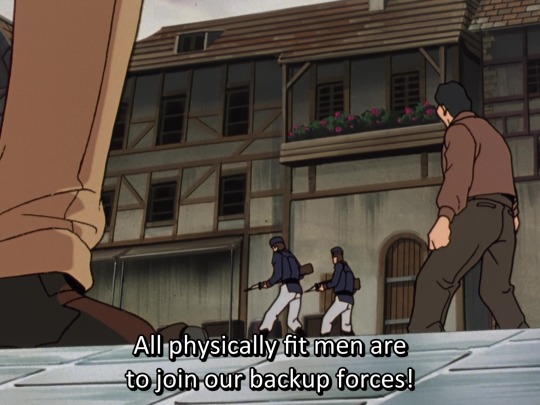
Why does this matter? Because in non-violent resistance, particularly in civil disobedience and non-compliance, it’s necessary to find ways to gain leverage that don’t involve offensive combat. In the case of resisting a military oppressor, learning what conditions allow the military to continue operating, and how to disrupt that operation, is of key importance.
Outside of Earth, we’re shown another notable example of disruptive resistance from the Winner family– adamant pacifists themselves, though their sole male heir, Quatre, broke with tradition and chose to fight against OZ using the Gundam Sandrock. The Winner family is in charge of several major natural resource satellites, a primary source of supplies for the adjacent Colonies. When those Colonies allied themselves with OZ and began arming themselves in spite of their past commitment to pacifism, and in spite of OZ’s quite recent manipulative and violent suppression of the Colonies, the Winner family patriarch protested this move vehemently. When it was clear the now-militarizing Colony would continue supporting OZ and intended to begin manufacturing weapons on the natural resources satellite, Mr. Winner removed his support from the Colony– both ideologically and physically, by decoupling the resource satellite; a move that cost him his life at the hands of OZ.
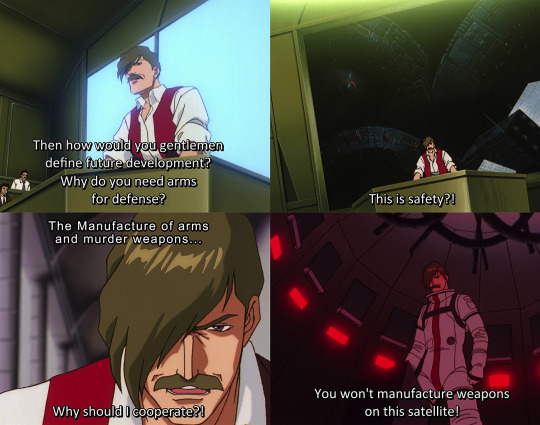
A Glass Kingdom Throws No Stones
The Sanc Kingdom’s existence is based on hope.
It assumes peace (i.e. a state of goodwill and non-conflict) is the natural state humanity longs for, the only condition it can truly flourish in, and therefore it is in everyone’s best interest to pursue. Even those who advocate in favor of war would eventually see the pragmatic benefit of peace– wars are costly, and demand a constant supply of resources and humans to throw into it. If everyone simply acknowledged these truths, True Peace ought to be the inevitable outcome.
This position is largely (but not universally) viewed as naive, idealistic, and ultimately hopeless. Even its proponents acknowledge that the Sanc Kingdom’s ideals are built on trust and air– but they maintain that their belief in that trust is nevertheless of utmost value, for inspiring others to realize what might be possible if that trust were universal.
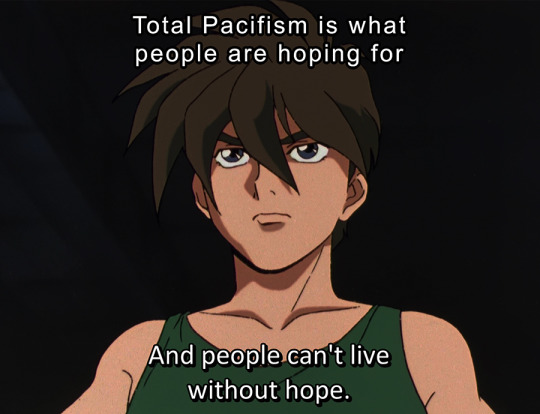
The Sanc Kingdom’s one defense is its total lack of offense. By removing itself as a potential threat and offering no resistance or antagonism to the ruling power, it minimizes the incentive for that ruling power to overrun and destroy it– but there are no guarantees.
Relena pragmatically warns her students that the Sanc Kingdom will never be a safe place until Total Pacifism is adopted globally. She herself is prepared for the likely scenario that advocating for peace will cost her her life. The tenuousness of the kingdom’s position is fully acknowledged by all– how could it not be? The current Sanc is built on the ruins of the previous generation’s bid for pacifism.
Despite this, the kingdom’s doors are open to all; Relena maintains a supremely generous view of mankind that gives everyone the benefit of doubt, continuing within the same logic that non-aggression will be met with non-aggression. Perhaps more accurately, this policy is her way of insisting that this is how peaceful interactions ought to be; despite the considerable risk they incur, both she and her kingdom stand defenseless in a world of grasping military powers, wielding only her dignity, her public visibility, and a conviction that everyone is capable of choosing respectful conduct.
The Sanc Kingdom is perfectly set up for martyrdom– and it is a very short ride before it gets there.
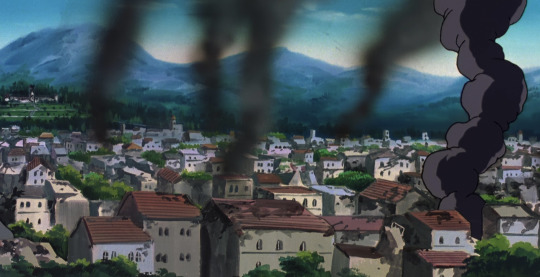
But the power of Relena’s ideals is not tied to the existence of the Sanc Kingdom– it’s not even tied to her, or the Peacecraft name. The naivety, the impossibility, of pacifism in an era defined by global military rule, is constantly reiterated, and yet it does not disappear.
Even as the bottleneck of war grows tighter and the violence between the ever-fragmenting world powers continues to escalate, the majority of people bearing witness to these horrors look to an alternative that offers hope, as practiced and advocated by a brave girl facing impossible odds.
The more pitched the violence becomes, the louder its perpetrators shout that peace is impossible, while to the people suffering its effects, the more outrageous and unnecessary that violence is revealed to be. The ones waging the wars seem to be the ones generating new reasons for them, their excuses becoming increasingly absurd, their justifications transparently thin.
Is it really so absurd or unreasonable by comparison, to take part in an actionable plan for peace?
“I’m aware that my views may appear to be a little naive to some people, but I wonder why people battle if everyone agrees that it’s foolish to do so? I don’t think that we’re too far from the answer.”
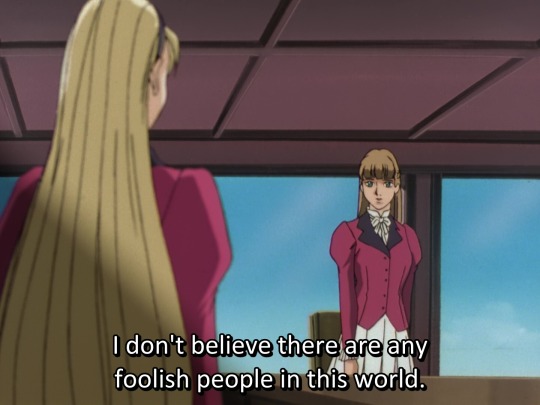
#Gundam Wing#Relena Peacecraft#Sanc Kingdom#After Colony#Gundam Wing Meta#Dorothy Catalonia#Romefeller Eyebrow Brigade#gundam wingtionary#wing watcher's toolkit#parsing post#i can't believe this entry is finally done hallelujah i'm free
92 notes
·
View notes
Text
“True Friends” - Understanding Mr. Treize and the Contradictions of OZ
“Treize himself has a tremendous disdain for any tactic that allows for excess casualties. Ignoble behavior on the battlefield sullies any victory, and civilian death makes a mockery of what a True Soldier fights and dies for. For Treize, there is nothing more hateful than removing the human component from battle, or the cowardly avoidance of responsibility for human death.”
Gosh! What a great quote! I wonder who said that? Oh right, that was me! I did. I wrote that in the entry about “True Soldiers: Aesthetics, Honor, and Chivalry”.
Let’s examine that a little more, shall we?
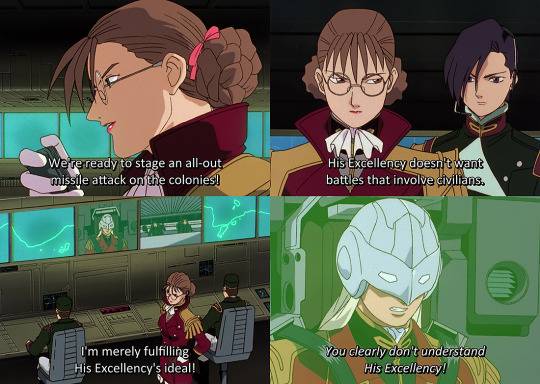
“His Excellency doesn’t want battles that involve civilians.”
Everyone who knows Treize best, his “True Friends”, who grew up with him, who were trained by him, who understand him, all seem to agree: His Excellency wouldn’t stand for needless casualties. OZ may be ruthlessly pragmatic and underhanded, but that couldn’t be Treize’s fault– no, it’s always Lady Une! It’s his fanatically devoted colonel who always chooses the path of greatest violence, heedless of any collateral damage– she’s the one to blame! Treize would never give an order that risked civilian lives.
…Right?
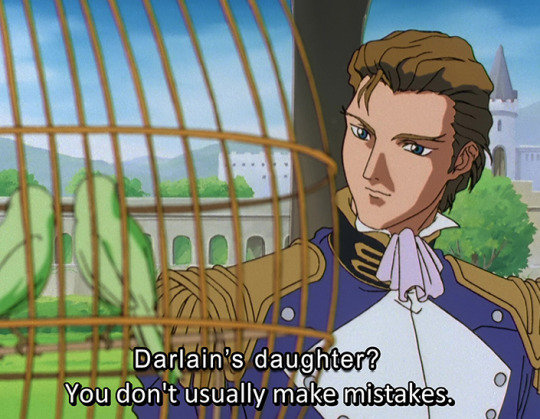
…Right?
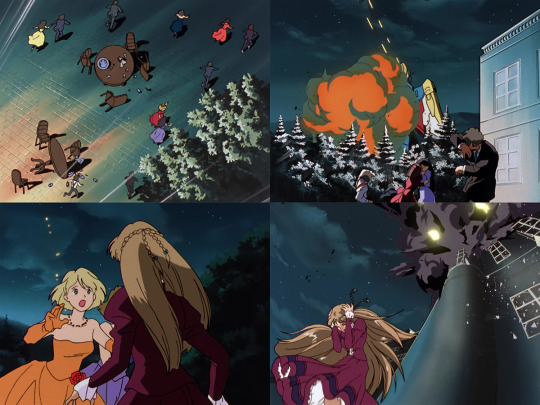
Surely he would stop her, admonish her, make her face serious consequences for the atrocities she was willing to commit. He’d leave no room for doubt that she had failed him and disappointed him.
...Right?
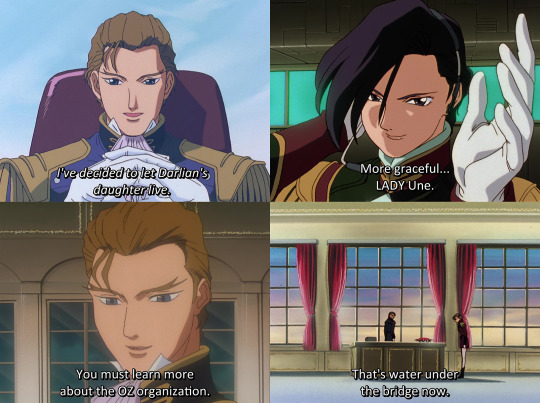
Yeah, that’s right, a firm slap on the wrist oughta do it. Tell her to try a little harder next time to understand the value of human life. Just do better! It’s alright to use mobile suits to attack a school, but we’re going to put a stop to it because I’ve changed my mind about killing a teenage girl, as a personal favor to a friend.
–Friends of His Excellency would certainly like to believe that he would never knowingly sacrifice civilians, but he sure doesn’t seem to mind benefiting from someone else doing it for him.
How well do Treize’s friends really understand him, when they seem unaware of how wide a margin of error he finds acceptable in pursuing his ideals?
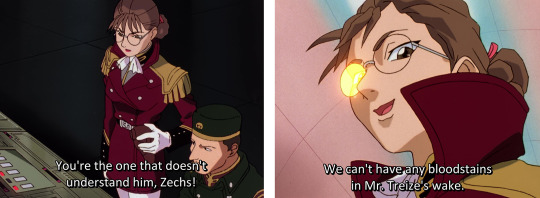
Well, ideals are fine and all, but war is war, and some amount of pragmatism is necessary to stay on top. Treize isn’t the one calling all the shots (yet), and the organization he reports to expects results. You have to break a few eggs to make an omelet, right? That’s why it pays to have a Chief Omelet Maker working for you, so she can break all the eggs, and murder school children, and threaten nuclear assault, and you can come away still smelling like roses.
…But what sort of effect does that have on her?
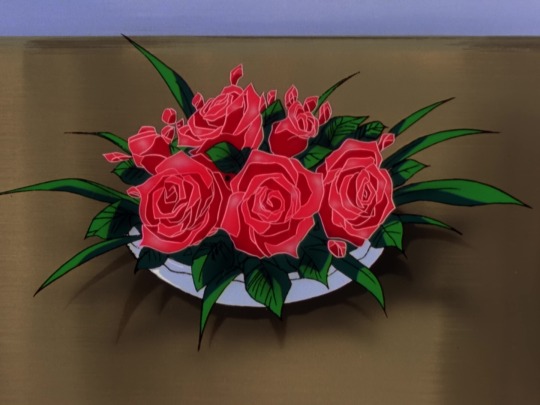

It’s better for a ruler to be feared than loved; being hated is the perfect motivation to stay strong; fighting will never disappear from the world, so the strong should rule it for the sake of damage control; God was too lenient when he gave mankind the free will to rebel; people find comfort in being controlled by the powerful.
--These are some of Treize’s stated ideals.
So Lady Une devotes herself to fulfilling those ideals unflinchingly, no matter how much blood ends up on her hands. Better her hands than His. OZ has to be the strongest. OZ has to win. OZ must be victorious at any cost. Damn the Colonies, damn the politician’s daughter who made herself a liability, damn the wounded soldiers left behind at New Edwards Base– she’s going to make OZ so absolutely unfuckwithable that their enemies shit themselves at the mention of its name, and she’ll do it herself if no one else will. Because THAT is what His Excellency wants. She understands him.
...So why does he keep telling her– ever so gently, ever so gracefully, that she’s wrong? If making sure the strongest rule and the weak obey isn’t what pleases him, then what will?
Killing is simple– anyone is capable of killing anyone, so you mustn't abuse that capability. The Earth is fragile and infinitely beautiful. Human life is fragile and infinitely beautiful. One must always take responsibility for the fates of those who fight for you, and honor the sacrifice of those who die. Tragedy in war is inevitable.
--These are some of Treize’s stated ideals.
So Lady Une devotes herself to fulfilling those ideals with grace and empathy, to bring an end to needless bloodshed. The world needs a strong, compassionate leader, who is capable of loving humanity and guiding them to a peaceful future, where loss and war are tragedies of the past. Order and peace can be maintained without sacrifice, by using technical advancements to replace soldiers on the battlefield and keep them out of harm’s way. That is what His Excellency wants. She understands him.
...So why does he tell her– so sadly, plaintively, that she is wrong? That he is not who she thinks he is, that the future she has so carefully laid out for him is a fantasy of her own making? Why does he plead with her to come back to him, as the person he once knew so fondly?
Civility and honorable conduct on the battlefield is worth more than victory. To fight for something one believes in with perfect clarity is the purest endeavor of mankind. The tragedy of loss is what gives a battle meaning. Honoring the sacrifice of those who have died for your cause means being willing to die for it yourself. To fight, to lose, to die for a noble cause is to move the hearts of all humanity, to touch immortality.
--These are some of Treize’s stated ideals.
And so she does– she sacrifices herself to save the Gundam pilots and turn the tides in outer space, rejecting Romefeller, rejecting the Mobile Dolls. At last, she understands him.

…But didn’t she always?
Except perhaps in the case of using Mobile Dolls to replace soldiers (an idea that was easily manipulated by its inventors to fit into her worldview at the time), her understanding of Treize’s ideals wasn’t ever wrong, just fragmented. She focused on a single facet at a time, each time excluding the contradictions of the other sides– light bouncing off a solid plane without revealing the rest of the prism’s convoluted geometry.
She isn’t mistakenly interpreting him– HE is a mess, and she is representing him accurately, one dimension at a time.
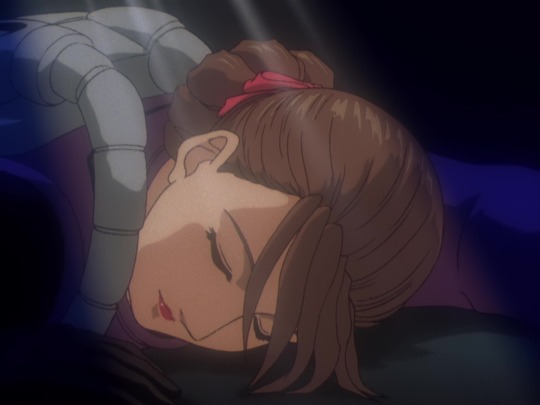
What is more significant is that he finally understands this about her.
Treize is mortified to realize what sort of effect he has been having on someone he cares about, during a period where he is questioning the validity of his own beliefs and significance. He may mistakenly believe that he is responsible for having fragmented Lady Une’s personality– which is not how the condition she has operates– but he is not mistaken in taking responsibility for her distress, and the danger he has put her in.
Losing her, or believing that he has lost her, is devastating. Rather than moving him to action, it moves him to inaction; aware that he has come to represent ideals that are too easily manipulated by people who he fundamentally disagrees with, that the idea of him is too powerful to be used responsibly by the current rulers, he withdraws.
Treize cannot switch off the magnetic field of his charisma or its continuous pull on the soldiers who take inspiration from him, but he refuses to willingly lend himself to a cause that he finds irresponsible. In fact, he refuses to join any cause until one presents itself that he can have complete faith in– and complete control over.

The people whom Treize considers his True Friends are the ones who “understand” him– this includes his enemies, the ones who oppose him but nevertheless espouse values that he can respect. In fact, ANY strongly held ideal, even ones in opposition to him, and ANY display of courage, is more admirable in Treize’s estimation than lip service to his own ideals or those of his organization. The “fighting spirit” that is of paramount value in his worldview is not limited to combatants– he expresses immense respect for Relena Peacecraft, more so even than his respect for the Gundam pilots, who he comes to idolize. What matters is the strength of conviction. What matters is courage.
He respects and admires Lady Une, even when her errors in judgment have megaton consequences, because she is so singularly and ferociously dedicated to her goals. He tolerates the violence and inhumane actions of the Specials and OZ soldiers because they are fanatically ambitious and ready to die for their ideals. As long as the ultraviolence isn’t cowardly or self-serving, then Treize can and will overlook the body count– noble sacrifices, all. He’ll memorize their names later on today.
Treize’s ideals are flawed and contradictory. There is a tipping point in the series where he gains enough self-awareness to recognize this fact. This does not stop him from believing in his ideals– he can’t simply turn away completely from what he values and loves about humanity and its “fighting spirit”– but it does allow him to appreciate those who see his hypocrisy for what it is, and who despise him for it.

“You’re only capable of looking down on others; you’re only fighting to satisfy your ego. How many people have died because of you?”
The fact that Treize has memorized the names of all 99 thousand people who have died for him does not do anything to improve Wufei’s opinion. For Treize, that number is a sacred personal burden; to Wufei, it is evidence of offensive, monstrous egotism.
Wufei, of all the Gundam pilots, is best acquainted with how wide the margin of error is in Treize’s ideal of chivalry. Nataku herself, the namesake for Wufei’s gundam, fell neatly into that margin and died in it. Long before they met and dueled, Wufei knew of Treize as the OZ official jointly responsible for an attack on his Colony. While General Septem of the Alliance (then in control) would have murdered everyone on the Colony indiscriminately with biological weapons, Treize’s solution was more sporting: OZ sent in Mobile Suit troops to directly eliminate the rebel element, who were armed with nothing but a single decrepit prototype Leo and an unfinished Gundam with no ammo-- a much more chivalrous way of sterilizing a Colony, allowing the largely unarmed group of dissidents to die fighting rather than be killed with the push of a button.
Would the deaths of the Long Clan have been meaningful sacrifices in Treize’s eyes? Was exterminating civilians for the sake of convenience a noble cause to fight for?
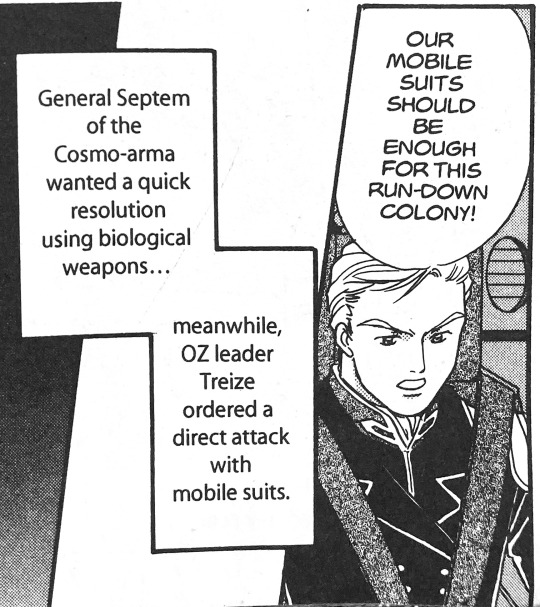
One could argue that the existence of the then-in-development Gundam was enough of a threat to justify an attack, but at the time the idea of gundanium mobile suits was no more than a rumor. Could Treize, back on Earth, have reasonably predicted its invention?
Not if we are to believe his own words, which clearly indicate that the Gundam’s existence was unknown to him until reported after the attack.
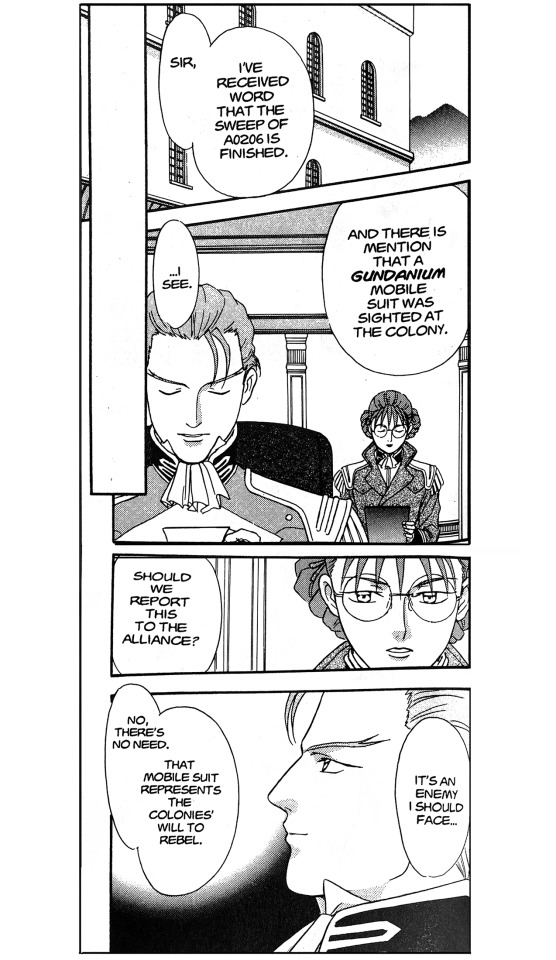

For those who fall outside of his cult of personality it is easier to see past the charisma to the reality: no matter what his soldiers think of him, Treize is not a god. He is only a man, and no one person has the right to decree some deaths necessary to the future.
–And Treize, for his part, would agree. He is a single individual, whose ideals people put too much faith in without fully realizing the essence of what they mean. But the belief people place in him gives Treize a level of power that must be acknowledged and used responsibly, and to the best of his ability, he tries to use it for the good of Earth and humankind.
As a symbol, he is far more influential than he could ever be as a man, and his awareness of that fact leads him to choose the path of martyrdom, knowing that his very existence is a threat to peace. The only way he can neutralize his own power as a military icon is to join the sacrifices to the cause. And what more iconic way to do that than with a duel?

Treize may have resigned himself to being an anachronism and a dreamer, but if he is going to die for the sake of the future, he will at least go out according to his ideals: gracefully, nobly, at the hands of an enemy he respects.
For personal and aesthetic reasons, Milliardo is Treize’s hopeful first choice as a dueling partner, but Milliardo had his own role to play in their final performance, which prevented him from participating in a duel for their mutual actualization. So Wufei is the right choice; Wufei both understands him and has a justified reason to want him dead. Besides, it’s an elegant, symmetrical solution– the continuation of a duel that he predicted they would be destined to finish in mobile suits.
--And what effect does that have on Wufei? Perhaps expectedly, a fracturing one.
It shouldn’t be surprising that Treize’s ideals resonate so powerfully with someone who was raised in a warrior culture, especially someone who only knows how to express his beliefs and sense his self worth through combat.
Wufei, too, lives with contradictions that he cannot fully unify.
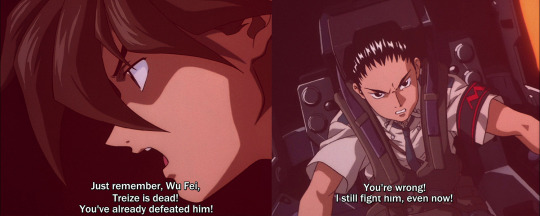

Treize Khushrenada cannot live in the world he wishes to see realized.
If he were to win the war against White Fang, the cycle of oppression and resentment would continue. Even if he were to immediately relinquish his power to Relena and demilitarize the Earth Sphere, the end result would lead to more conflict; his refusal to take control of the Colonies would be seen as capitulation, and a betrayal of those who fought for him against the threat of annihilation from space. Even the considerable power of his charisma would evaporate overnight if he were to appear to be turning his back on the soldiers whose fanatic loyalty had allowed the unified mobilization of Earth’s military forces under his banner. But, as a general leading from the front lines in a noble defense of Earth, dying gloriously in battle for the sake of peace lends all that charisma to the future he fought for.
--The message left to the surviving soldiers is not: “His Excellency led us into battle and then abandoned us when he won”, but instead: “this is the peace His Excellency died protecting.”
Indeed, after his death, Treize’s name IS used in an attempt to lend legitimacy to the argument that soldiers have been devalued in a time of peace, and that continuous war to determine the strongest victor to lead humanity is his true legacy. But it doesn’t stick– the would-be dictator who tries to use Treize’s name in service of his military takeover is killed by a nameless soldier, whose change of heart is motivated by the memory of what Treize actually died for.
--It is not a victor who moved the hearts of the people, but a glorious loser.
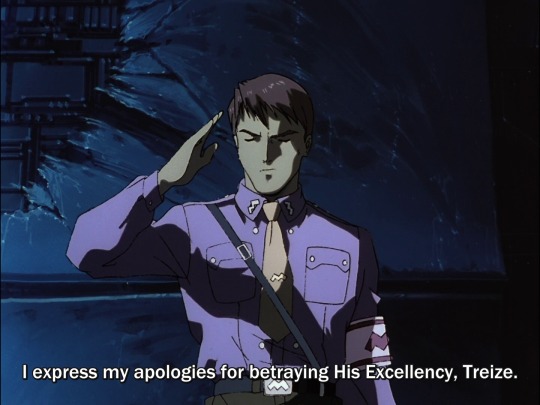
#Gundam Wing#Treize Khushrenada#Lady Une#Chang Wufei#Endless Waltz#gundam wingtionary#wing watcher's toolkit#tinyozlion pgw#parsing post
70 notes
·
View notes
Text
“True Soldiers”-- Aesthetics, Elegance, and Chivalry
What it means to be a soldier, and what fighting means to humanity, are questions that dominate the characters of Treize Khushrenada, Zechs Merquise, and Dorothy Catalonia– the Romefeller Eyebrow Brigade, if you will. (Zechs is an honorary Eyebrow. He was socialized an Eyebrow).
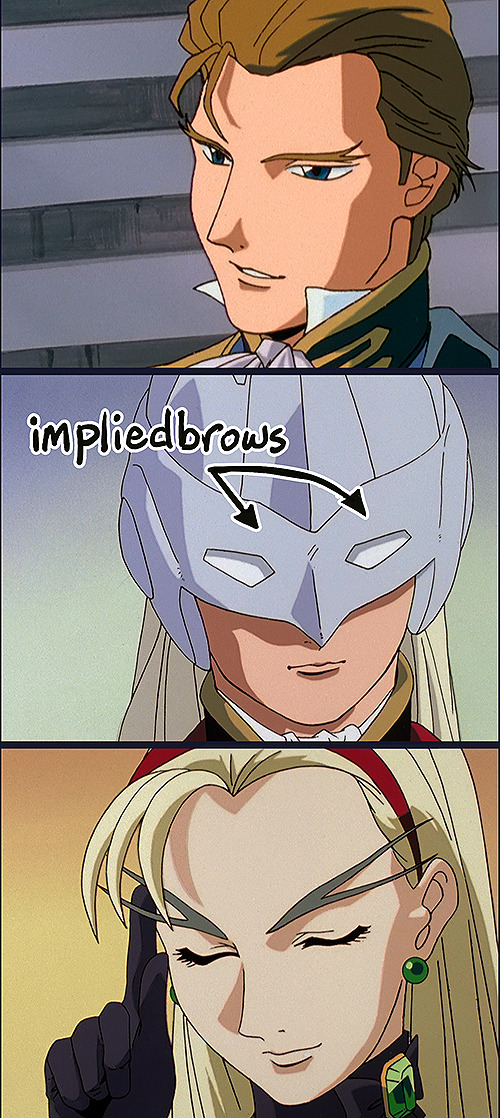
“True Soldier” is the term we’ll use here, though the idea it embodies has a lot of synonyms in the series that are all used interchangeably (much like “peace” / “true peace” / “pacifism”). "Soldier" is actually a bit misleading, because in this context it does not come with any of the associations of service, or being part of a unit, or being aligned with a military organization in general. A "True Soldier" is the same as a “warrior”, a “fighter”, or sometimes just "soldier". If the characters are waxing particularly Eyebrow-y, you might even get “knight” or “hero”. Even though the series still uses "soldier" in its usual definition (i.e. a person serving in an army), it’s usually pretty obvious when a character is talking about True Soldiers™ in a meaningful, Gundam-specific way.
Really, it is Treize for whom the questions about the meaning of fighting and humanity are paramount– both Zechs and Dorothy, who grew up with him as friend / family, are drawn into his ideology by the gravity of his personal charisma. The pull of Treize’s ideology is so powerful, in fact, that Zechs spends a significant amount of time trying to escape from its orbit, and repeatedly fails.
For Zechs, the essence of being a “True Soldier” is to fight for a personal, often intangible victory: to test one’s own limits, to honor a worthy opponent, to find meaning in struggle, and ascension in victory. He fights to test himself, but also, significantly, to achieve his personal aim of avenging his family and fallen country. Whether he wishes to fight as Treize’s chivalrous knight to attain personal clarity, or to fight earnestly in the defense of what is in need of protection, is a duality that he struggles to reconcile. But his perception of what makes a True Soldier remains: someone who fights for a meaningful cause. Or aretḗ, if you will (and you will, because that’s the best definition for what both Zechs and Treize consider “honor”, or “nobility”.)
Treize takes this a step further: for him, a True Soldier not only fights for something beautiful, whether to better themselves or for a selfless cause, a True Soldier puts their life on the line to give meaning to that conflict. The more one is willing to risk in battle, the purer and more noble the fight is, the more potent the sacrifice. In that sense, to lose the fight is to have the greater victory of experiencing martyrdom. He does not glory in death, but he finds immense, incalculable value in the deaths of those who die fighting. To Treize, dying for something noble is akin to apotheosis.
Compare this to Wufei’s conviction that only the strong can or SHOULD fight, that losing is a sign of weakness and weakness is a sign of inferiority. The weak gain nothing from fighting, because they will only die. For Treize, there is power and dignity in losing a hard-fought battle for something one believes in. For Wufei, losing is a disgrace that bars you from the right to take up arms and fight. It’s easy to see why Wufei and Treize see one another as their rightful nemesis, stuck in each other’s orbit.
Dorothy, meanwhile, cares much less about avoiding casualties or fighting with civility; to her, ALL death is a glorious sacrifice, part of a means to an end. ALL fighting is equally fascinating, equally awe-inspiring. People who profess to hate war, yet fight against it? Exquisite! Divine! Relena is just a delicious vector of contradictions that causes people to fight and die for her, despite hoping for an end to death and fighting! What priceless drama war provides. Man is a fighting animal and it is only through conflict that we find meaning. War is disgusting. Man is disgusting for loving war. The two deserve each other, they will go down in flames together, locked in passionate embrace. How absurd, how obscene, how beautiful.
It is worth noting that the one time Dorothy balks is when Zechs aims to annihilate Treize with the Libra cannon, eschewing noble combat in favor of brutal overkill– a move that was necessary to prove his dedication to the role of Earth’s villain, who would not be swayed by previous personal attachments. It is a move so counter to everything Dorothy believes in that her otherwise iron resolve cracks. To her, Treize represents the ultimate ideal of nobility in fighting, and also the perpetuation of fighting– destroying a beautiful, doomed knight with the mere push of a button? The same gutless, impersonal tactic that Mobile Dolls embody? Even for the sake of Zech’s war to end all wars, she cannot abide this.
In Treize’s ideology, war is merely the condition that allows humankind to express their natural desire to fight. But Treize himself has a tremendous disdain for any tactic that allows for excess casualties. Ignoble behavior on the battlefield sullies any victory, and civilian death makes a mockery of what a True Soldier fights and dies for. For Treize, there is nothing more hateful than removing the human component from battle, or the cowardly avoidance of responsibility for human death. How many people have died for him? He’ll tell you the exact number. He’ll also tell you that none of them died in vain. Because if there is no sacrifice in a war, no willing risk of human life on both sides, then it is a meaningless slaughter; it allows for no end state, no ideals, only murder and subjugation by those unwilling to risk their own lives. “Wars with no civility only give rise to massacres.”
…And, well, that’s stupid, isn’t it? The absolute assurance that only willing participants will be at risk, the guarantee of zero unintended casualties, and total adherence to civility in a fight, are the traits of a duel. And for Treize and (for a time) Zechs, wars ARE duels, or they ought to be. But that’s not how wars operate, and they never have.
Countries pitting armies against each other for sport and glory leads to trench warfare and mustard gas, not knights saluting each other across a pristine field. And whether knights as a rule ever did battle this way in the first place is pretty dubious. Knights were knights because they could afford to be in the literal sense: they had money for armor, for destriers, and time to spare on training rather than farming. In Europe, knighthood and chivalry are joined at the etymological hip: they both stem from the state of being a nobleman in the military who fights on a horse, while the so-called "chivalric code" is a much later invention. Chivalry as a code of honor is inextricably bound to the ideals of medieval Christianity and romanticization of the Crusades. Just like any Golden Age, the romantic Age of Chivalry can’t be found anywhere in history except “back in the day”-- but an age of knights and paladins certainly did exist, and I challenge you to look at any account of the Crusades and come away with the idea that they were cleanly, noble, justified affairs. Literally the first entry of the Crusades is a civilian massacre.
If a mounted knight did maintain a policy of eschewing personal combat with a weaker, unarmored opponent, it would be because there would be very little need to do otherwise. A lone peasant infantryman doesn’t present a significant threat to heavy cavalry– in medieval terms, those are tanks. Would “chivalry” in this context just be the ability to afford discretion on the battlefield? And would that chivalry make much difference to the total body count of a war? Wars, even preceding the modern concept of Total War, do not typically go out of their way to tread lightly on civilians. Indeed, historically civilians were by far the most typical people involved in wars. The professional full-time military is typically credited as being the invention of the Roman Empire, which again, could afford to devote a huge populace of able-bodied men in their prime to something other than agriculture and labor. (…And if you bring up the Spartans, I swear to god, I will put a curse on your house. Of course the highest of the elite aristocracy can devote themselves to full-time combat training when more than half the population of their city-state consists of slaves forced to take care of every other activity needed to sustain society). Wars tend to come to a natural conclusion when one side stops having enough civilians to throw in the meat grinder and still have a country left over afterwards, so finding cost-effective ways to wipe out civilians and soldiers is usually a primary objective of the people funding and providing the impetus for wars (less so for those making money off of the continuous demand for weapons– i.e. Romefeller). Efficiency makes wars end faster! And efficiency is a great excuse for justifying massacres; it is WAY less conducive to justifying civility.
Hawkeye: War isn't Hell. War is war, and Hell is Hell. And of the two, war is a lot worse. Father Mulcahy: How do you figure, Hawkeye? Hawkeye: Easy, Father. Tell me, who goes to Hell? Father Mulcahy: Sinners, I believe. Hawkeye: Exactly. There are no innocent bystanders in Hell. War is chock full of them - little kids, cripples, old ladies. In fact, except for some of the brass, almost everybody involved is an innocent bystander. --M*A*S*H, 1972
“There’s no formality when it comes to killing men. If there were, it would be in the form of a game where people’s lives are toyed with. In war, a frenzied death is the most honest way.”
Relena does not see war through the rose-colored glasses of the Eyebrow Brigade. What do “chivalry” and “honor” even mean in a war? An individual can maintain a code of honor– but unless you somehow ensure that everyone involved, from general to recruit, is fighting for the same reason, using the same rules, in the same manner, an army can’t. Unenforceable moral aesthetics applied to the actions of armies are a farce that puts a pretty bow on state-sanctioned murder. It’s propaganda.
But if you’re fighting a losing battle that you believe in, you don’t have the luxury of chivalrous conduct– you can still have a conscience, but you don’t take time out to make sure you and your opponent are evenly matched and emotionally on the same page before engaging. If you’re protecting something, or resisting oppression, you fight messy and kill when you need to and die in whatever ugly position you land in, because you have no other choice.
That’s how the Gundam pilots fight. It’s desperate, and brutal, and inglorious every step of the way. Whether they win or lose they keep fighting, because that’s what they have to do to be the catalyst of change. They put everything on the line: their lives, their dignity, their reputations, their identities, and when they fight, they lose over, and over, and over again.
--And the Eyebrow Brigade is OBSESSED with them for it.
The Gundam self-detonation is a shot heard round the world. It isn’t as if the members of OZ have never seen people sacrifice themselves before– Zechs has several martyrs on his conscience already. But there is nothing to soften the impact of seeing the enemy war machine open up and reveal a child as its pilot, and then watch him unhesitatingly press a switch to self-detonate. They backed their enemy into a corner and gave him an unthinkable ultimatum, and instead of choosing, he rejected the dichotomy entirely and took himself out of the equation. Without blinking. They watch a 15 year old die rather than acquiesce to atrocities, and everything they’ve done in the war to that point is lit up in the unforgiving floodlights of that act. Even if they still half-heartedly believed in the “liberation” OZ had given the Earth Sphere, was it worth this? If this was the opposition, who were they?
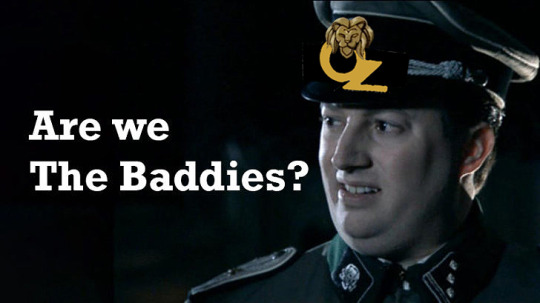
If a True Soldier is someone who puts everything on the line for their purpose, who sacrifices themselves to give meaning to their fight - then they’re looking at him. What’s left of him.
Zechs’ fight with the Gundams changes his perspective so thoroughly that he throws away his entire military career. It’s not just his job– it’s the career he compromised his Peacecraft identity for, the career that offered him security as a political exile, as well as fame and self-actualization. He wants so badly to achieve that state of clarity the Gundam pilots have that he rebuilds Heero’s Gundam just so they can continue the fight, so Zechs can learn what makes a Gundam pilot tick. He tries to force himself to fight without civility, to try and escape his own dependence on aesthetic combat. The irony is not lost on him that he is staging combat in order to do away with the formalities of staged combat– but he’s still unable to avoid it.
Noin, being the smart cookie of the couple, already gets why people who fight for something tangible have clarity. SHE has that clarity– she fights for Zechs, and for Relena. She knows that Zechs is perfectly capable of that clarity himself, because there are things and people dear to him that absolutely need protecting! But she also knows Zechs well enough to know he has to realize that for himself. No amount of persuasion can get Zechs to change direction once he’s committed– only blunt force. (The people who know him best seem to all understand that, except for Relena, because Relena is a chip off the same stubborn-ass Peacecraft block.) His fight with the Gundam pilots shatters Zechs’ confidence so profoundly that eventually, he’s forced to take off the rose-colored glasses he’s been wearing ever since he and Treize became friends. He is suddenly aware of how shallow his honor is as a “knight” fighting for nothing except his own betterment, a puppet of an organization with no guiding principles.
Treize’s change of mind takes longer; it’s a slow erosion, not a shattering. His ideals are so intrinsic to his sense of self that changing requires him to kill his ego and voluntarily exile himself from the world stage. The bravery, the tenacity and selflessness of the Gundam pilots is such a perfect demonstration of his ideals that it begs the question: Why is HE fighting? What was it he had wanted to create with the Specials? Knights on the battlefield who could operate according to their will, yes– but with no clear objective to fight for besides being the best? Was eradicating the Alliance– so offensive to him when it was in power– worth his involvement, when its successor had run out of patience for him, and all his inconvenient ideals about civility and sacrifice in war? The Gundams, and their proponent for peace in the Sanc Kingdom, are the ones truly fighting for what is beautiful and good, and therefore truly living. And what has he done? What is he doing? It’s impossible for him to lend his support or his influence to the organization that backed him in his rise to power. To do so any longer would be to betray his most fundamental beliefs– unacceptable, even when cannot live according to those beliefs himself. Treize struggles to find his own purpose in a new world of dehumanized warfare, and his isolation and turmoil do not end until Zechs presents him with the opportunity, at long last, to fight for his ideals– and die to give them meaning.
Zechs and Treize never truly abandon the ideal of the “True Soldier”. Their beliefs evolve, and in Zechs’ case must be disguised, but the belief itself– in that chivalrous, virtuous battle that ennobles humanity– persists in a more self-aware state until the end of the war. It’s the very thing that allows them to commit to sacrificing themselves for the sake of a peaceful future they cannot participate in.
And the Gundam pilots, continuing not to care what kind of soldier they may or may not be, changed the trajectory of their enemies so dramatically that they found themselves traveling in the same direction. In the end, the victory they’ve been looking for is their own redundancy– nothing more and nothing less than the ability to simply stop fighting.
(…Except for Wufei, because he’s… well, it’s complicated. But we'll get to him.)
#parsing post#gundam wing#treize khushrenada#zechs merquise#tinyozlion pgw#Wing Watcher's Toolkit#Gundam Wingtionary
58 notes
·
View notes
Text
Wait, How Many Wing Zeroes ARE There?!
“Three Wings for the Elven kings under the sky Seven for the Dwarf lords in their halls of stone...”
So, by the end of the series it seems like there must be a Gundam 01 parked conveniently wherever you need one. This isn’t a huge mystery or anything, it’s just a bit confusing because Gundam 01 has been updated, reconstructed, and rebuilt about a dozen times by just about everyone.
The first Gundam 01 is what Heero comes to Earth in-- I'm going to refer to it as the "Wing Gundam". (Back in the Colonies, the Doctors Five have made plans for an updated Wing Gundam that is bigger, badder, and more space-worthy; but that Gundam hasn’t been built yet, and the AI system that will be installed in its cockpit hasn’t been implemented *).
Heero uses the Wing Gundam until episode 10, whereupon he hits the switch that shoots it directly into God's grundle.
Zechs, being the die-hard Mobile Suit nerd he is, sweeps up all the pieces, orders a bunch of extra Gundanium, and rebuilds it specifically with the intention of giving it back to Heero, who he senses is still alive.

The idea of giving the enemy death machine back to the enemy pilot understandably causes Romefeller’s monocle to pop out into its tea, and they tell Treize to make his boyfriend blow up the rebuilt Wing Gundam. Treize *wink* definitely *wink* tells him to do that right away *wink*.
(Zechs is a political exile with a military salary; he does not have the kind of pocket change you need to buy two Gundam’s worth of Gundanium, express delivered from Outer Space. Do you know who DOES have generational wealth to throw around? Treize Khushrenada, a man who does not skimp when it comes to getting his friends everything they want.)
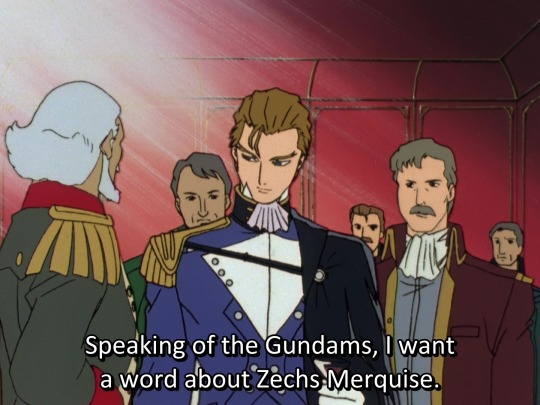
"The word better be 'flawless'."
Zechs blows up a Wing Gundam, but it’s not the real Wing Gundam, it’s a fake made from the spare parts of his Tallgeese MS, the rest of the supply of Gundanium, and 18,000 Gunpla kits he bought on Ebay. No one is really convinced by this performance: his reputation as a Mobile Suit nerd is too well cemented at this point. In any case, events unfold and Heero and Trowa take the reconstructed Wing Gundam.
THIS IS WHERE A SWITCHEROO HAPPENS. The Gundam pilots attempt to head to space, which goes poorly for everyone. Heero dumps the Wing Gundam in a lake and goes to space without it.
MEANWHILE: Quatre, who was forced to detonate the Sandrock Gundam and is having a bit of a rough time, finds the Doctors’ blueprints for the shiny, updated Wing Gundam, which is called the Wing Zero– because it has the ZERO system programmed into its cockpit.
So now there is the Wing Zero in space, and the original/reconstructed Wing Gundam back on earth, chilling with the fishes. In fact, if everything else is too confusing, just remember: Wing Gundam stays on Earth.
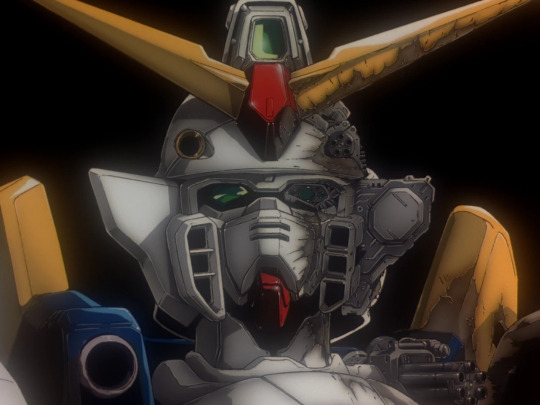
Stuff happens in space and Zero is left behind while the boys return to Earth. OZ now has the abandoned Wing Zero, which it plans to blow up. Zechs manifests out of the woodwork because once again he is a nerd who cannot let a good Mobile Suit go to waste. He changes out the Tallgeese (RIP) for the Wing Zero, and thoroughly enjoys having a shiny new Gundam to play with.
Meanwhile, back on Earth, power team Sally-Noin recovers the original/reconstructed Wing Gundam from the soup, and gives it back to Heero. Unfortunately at this point, Wing Gundam is a little the worse for wear and underpowered for the waves and waves of VirgoMDs being sent its way. The tough old bird eventually meets its match and goes down under fire, but not before one Treize Khushrenada phones in to its pilot and tells him to meet him for a brunch-and-joint-suicide date over at the abandoned Disney Castle.
Original Wing Gundam is toast, Heero gets the Gundam Epyon from Treize, and Zechs conveniently heads to Earth in the Wing Zero.
Heero and Zechs fight, their Gundams (both running on the ZERO system) refuse to hurt each other because they’ve… never felt this way about another Mobile Suit before… is this what humans call… love? Zechs and Heero do not understand their Suits' beautiful relationship and refuse to let love bloom on the battlefield.
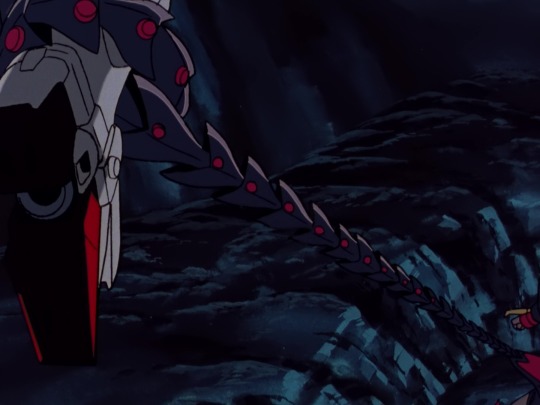
Oh it's like THAT huh?
Heero gives Epyon to Zechs, and takes back Wing Zero, which he prefers piloting because it doesn’t have Treize-cooties on it, even if he has to re-adjust the seat because Zechs is taller than him.
Heero stays in the Wing Zero for the remainder of the series– BUT! The wreckage of the Wing Gundam is still on the battlefield, where it is retrieved by OZ / the Treize Faction. The now twice-rebuilt Wing Gundam is patched up once again by nerds after Zechs’ own heart, who do it seemingly for the love of the game and the professional pride of a Gunpla enthusiast.
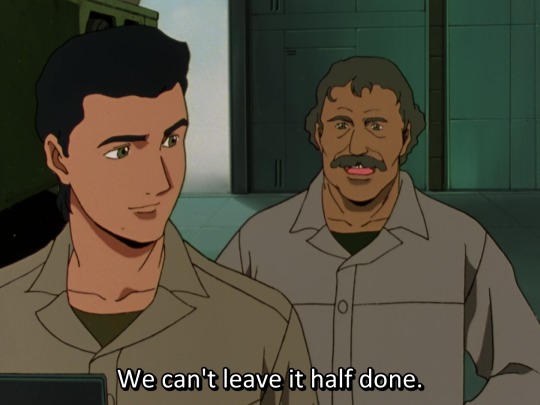
Wing Gundam is left in the hangar with the keys in the ignition… awaiting the call of DESTINY. Destiny comes in the form of Lady Une, who, sensing Treize trying to die heroically in space, rushes to save him in what is truly the last flight of the Wing Gundam: taking the hit meant for TallgeeseII (itself rebuilt from the remains of the Tallgeese) and staying intact just enough to keep its pilot safe.
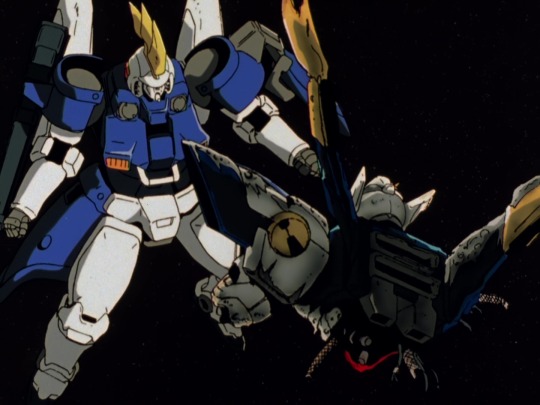
…Do you think Wing Gundam still had some of the old Tallgeese parts left in it? Do you think they remember each other? Am I getting emotional thinking about a Mobile Suit enemies-to-lovers arc? Do Epyon and Zero work out their differences before the end? These are questions I cannot answer; we must all decide for ourselves if the robots can kiss.
–OH! And you may be asking: Where does that sickass Gundam from Endless Waltz come from?? The one with the ACTUAL WINGS and robo-feathers and stuff! Don’t worry about it, it’s the same Wing Zero, everyone got a cool aesthetic redesign for the movie**.
____
*) …This actually depends on whether or not you take the events of Frozen Teardrop to be canonical. If you do, then the ZERO system predates the Gundams by a whole generation, and it’s based on the digitized clone of a Norwegian Forest Cat named ‘Sam’ who belongs to the Peacecraft family and was uploaded to a prototype MS by a young Doctor J and I am not joking. That is the original granddaddy of the ZERO system. It’s a digital cat-based user interface that lives in a Mobile Suit tamagotchi and communicates with the pilot by meowing. Is this insane? Undoubtedly. Do I love Sam very much? Yes sir I do. He’s a cat with a job. He’s the very best Meowble Suit combat AI, yes he is, yes he is. **) And THIS depends on whether or not you take the Glory of Losers rewrites as canon! Because in that version, the whole lineage of both the Tallgeese and Wing Gundams is slightly different, and the fancy robo wings are actually from the Tallgeese!
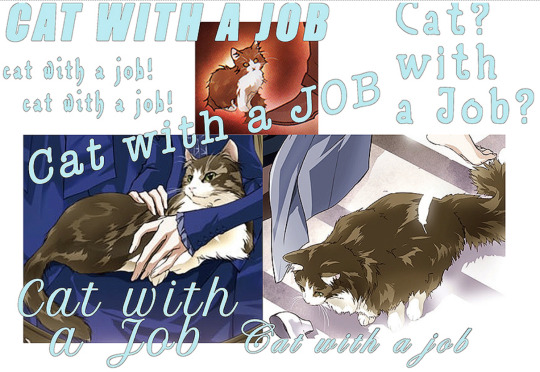
#I've peaked with 'Meowble Suit' I will never top this#gundam wing#Sam the Cat with a Job#wing watcher's toolkit#parsing post#tinyozlion pgw#Tinylion
53 notes
·
View notes
Text
“Honor, Justice, Strength, Integrity” - Why Wufei’s 'Honor' is Different

Here’s an analogy:
Someone stands up proudly in the debate club. They say “Today I’m going to be arguing strenuously for a topic I know almost nothing about and can barely articulate my stance on, but I’m going to opine about it at length and with great authority.”
And you’re like: …Why?
Do you enjoy being humiliated? Do you like losing? Is this something you do often?
Why? Why stand up at all when you have absolutely no chance of making your point?
This is how Wufei feels about fighting. Wufei, after all, IS a debate kid.
People who have no way of defending their argument should stay seated. They shouldn’t be here in the first place. If you’re too weak to win, you’re only a detriment to your own cause; when you’re weak, you make your cause look weak, when you lose, your cause loses.
So sit down. You’re in the way. You’re embarrassing yourself.
--If most of us look in our hearts and think of something that we would, honestly, truly, stand up and throw a punch / take a punch for, our ability to WIN the fight isn’t necessarily part of our criteria for doing it. If you gotta punch a bully, you gotta punch a bully. We view that as having integrity.
Wufei would not agree– if you punch the bully and the bully wipes the floor with you, does it mean anything to anyone but you? And does your feeling of validation make it worthwhile to participate in a conflict that hands your enemy an easy victory? The bully is still Evil, he wouldn’t say otherwise. But you didn’t change that by getting your ass kicked; the bully lives to bully another day.
Why throw your life away for something you can't change? If the only thing you can do for you cause is die for it, then you need to get your priorities in order-- you should get better at fighting so you can WIN for what you believe in, or get out of the way of those who can, so you don't become a liability.
If a cause is worth fighting for, then as its champion you'd better commit to being strong enough not only to achieve victory, but to defend and enforce it– or don't you believe in your stance firmly enough to follow it through? If you can't bring yourself to implement it without hesitation, then your cause is not a worthy one. If you don't fully believe in the cause you're fighting for, then indecision will make you weak, and you will fail.
And it will be right that you fail. Because fighting without a unity of both commitment and moral authority is how you lose your way. It’s how unnecessary conflict and Evil are born: from the disorder left in the wake of those who fight without understanding of what they're trying to achieve or lack the resolve to implement it without compromise. To him, that internal unity of purpose is the measure of integrity. Never go to war without it.
“Honor” for Wufei is different from the “aretḗ” of Zechs and Treize. For Wufei, honor is a score you’re keeping with yourself and your family and your clan and your ancestors and your dead wife who’s spirit you idolize. It’s not glory, it’s not chivalry– honor is your reputation. It’s a designation of value assigned by your community; it keeps you accountable to them. If you are humiliated in battle, it disgraces you AND your community, and it is therefore their right to ostracize you. Honor is something you can lose-- not just by failing to meet your personal standards, but by by failure in general.
A circumstantial loss is one you can strengthen yourself against and bounce back from-- but a true defeat, one that ends with you knowing you've been bested by a far superior opponent? That is a failure. A deep and bruising mark of dishonor that makes you unfit to wield a weapon.

There’s an interesting, if perhaps cynical, description of “honor culture” that identifies it as a response to living in impoverished, tenuous, often remote conditions where there is minimal or no law enforcement. Your mileage may vary on that assessment, but one thing’s for sure, Wufei’s colony, the A0206 colony of the L5 cluster, fits all of those criteria.
The Long clan’s reputation for great strength led them to be exiled by an insecure government to a decrepit, 200 year old relic of a colony teetering on the brink of extinction at the very edge of civilization. They have no money and few resources, their population is dwindling, the life support systems grow more tenuous by the year. The Alliance / OZ think of the people still living in L5 as vermin skittering around space trash. The Barton Foundation’s original plan for Operation Meteor designated A0206 as the colony destined for earth drop. Both Earth and Space seem in agreement that his home is scrap metal waiting to be disposed of. The only resources of value Wufei's clan have are the few young people like him who are capable of fighting, and their honor as a people. (…And one Gundam with no ammunition.)
The Long Clan is depicted as being very strict, proud, and extremely conservative. They adhere to a Confucian tradition that values obedience to social hierarchies, and the acceptance of one’s social role within that hierarchy. It is understood that those with superior standing should maintain virtuous and moral conduct, and that those who are subordinate should obey them as long as this remains true. Civil order and peace is the expected result of maintaining this propriety. It is also expected that people strive for perfection and harmony in every aspect of life, with the understanding that perfection is a state that can be achieved. It’s very likely that the strict adherence to these very traditional precepts is what helps A0206’s small, endangered population maintain cohesion in the face of constant peril, and it would explain why these traditions have close to a religious significance for those living there, including Wufei.
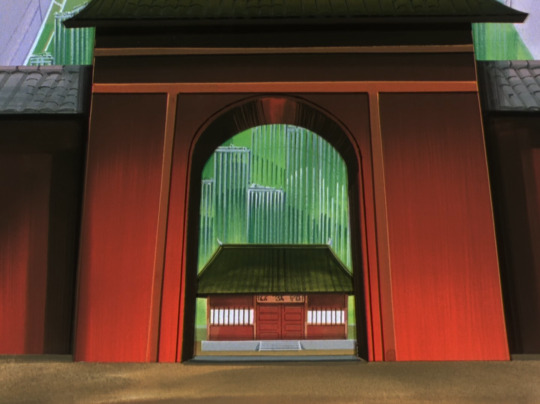
The hierarchies of this system are fundamentally patriarchal. Meilan is considered the “strongest in her clan”, but this seems to be something of a ceremonial designation, as she is repeatedly told not to fight in real battles on account of being a woman. In fact, it she seems to be the only woman with a visible presence in the colony. It’s possible that women are a rarity in the declining state of A0206, thus giving her increased value and status and making the rest of the clan overprotective of her-- but whatever the case, she must take on the spiritual mantle of Nataku to transcend her status as a woman and fight.
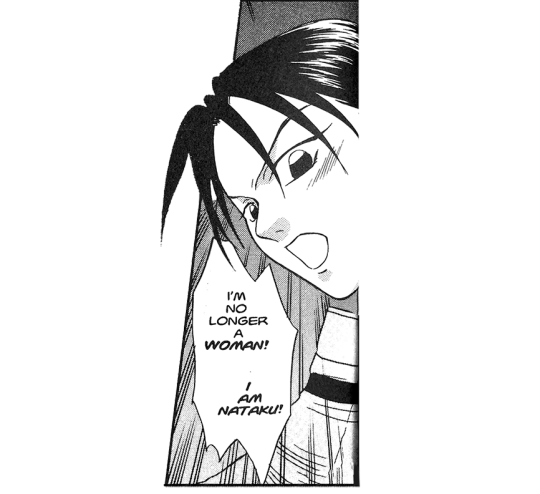
This is partly why Meilan finds Wufei so deeply infuriating when they first meet: she and Wufei are the strongest and perhaps ONLY members of their generation who are able to fight, and he (the one allowed and expected to fight by virtue of being male) refused to do so. Wufei did not see the point in fighting for a subjective concept– “Justice” lacks an absolute, universal definition, and therefore could not be defended.
--Like I said before: debate kid.��
Besides being an infuriating nerd, Wufei risks his whole clan’s reputation by refusing to commit to the fight against the Evil. (…Also, they were about to be exterminated by the Alliance, so choosing to let everyone die rather than be rhetorically incorrect was a bit of a dick move– as his mentor Doctor O astutely observed). When Meilan shames him, it is specifically for being a failure as her husband, as well as for shirking his duties as the most capable member of the Long clan. For both of them, propriety is of key importance.
But unlike Wufei, Meilan has no trouble reconciling her conviction to fight with her sense of justice. To her, it’s obvious that the universality of justice is infinitely less important than making one’s own idea of justice a reality.
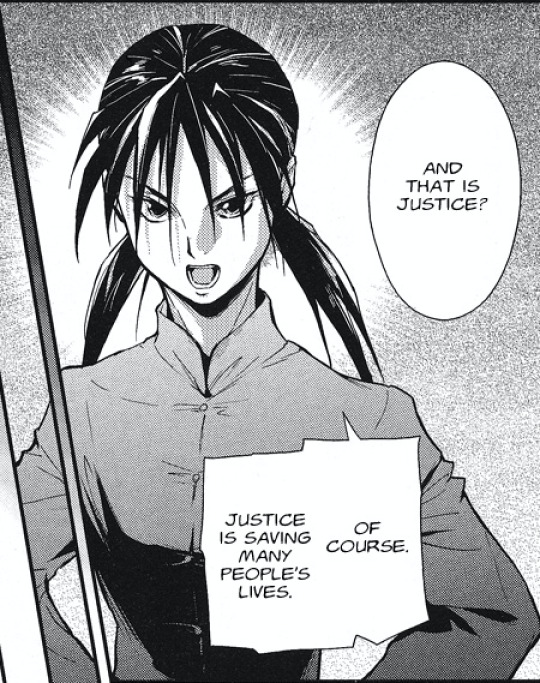
She isn’t having any of that what-about-ism bullshit– she is unhesitatingly ready to fight for what she understands to be true: that those who kill indiscriminately and oppress others for gain are Evil, and must be stopped so they cannot continue to do harm. And she fights also because… that is their way. The last and most enduring thing her people have is their identity, as ones who fight to uphold justice.
Ultimately, Meilan is killed while protecting the colony and Wufei. She is strong enough to win, but not strong enough to survive the victory. Their colony, their clan, and one the last few beautiful things they have managed to cultivate in spite of dereliction– their field of flowers, are safe for another day. If she hadn’t leapt to their defense first, Wufei would not have followed in the Gundam, and the population of the colony would likely have been killed en-masse by the Alliance, or decimated by OZ. She was directly responsible for their survival. Evil did not win, and yet, she died. She was strong, and yet she died. She was weak, and yet she was Justice embodied. Such a contradiction meant the universe had gone insane. It lost its way, it stood in need of correction.
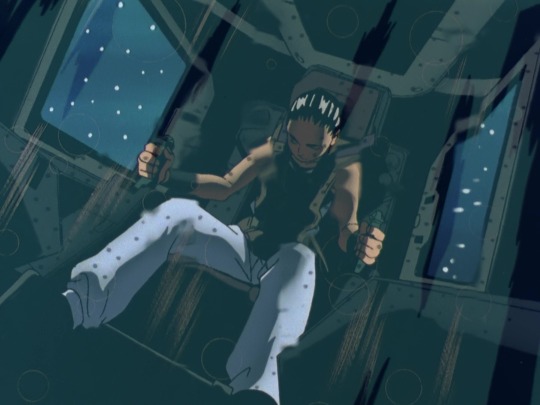
Wufei does not handle contradictions well. His ideology consists of absolutes and has no room for failure or extenuation. When the weak fight, they die, or they get in the way, so they shouldn’t fight. But Meilan– Nataku, was strong, and so, her spirit must live on in the Gundam, undying. It is her strength, her justice, which carries HIM to victory by lending him the strength of the mobile suit she died protecting. He must believe this, not only to honor her memory, but to preserve the structure of his ideology.
When he encounters women in combat who remind him of her, he reacts with outbursts of sublimated anger and grief that is redirected into misogynistic vitriol. Women who fight will die, don’t they understand? They continue to pick up arms and fight anyway, even when they’re weak, even when they cannot possibly win. They’ll foolishly rush ahead because they believe in what they fight for, and it will kill them. But he will not be the reason for it. He will make them understand that they are weak, so they will stop fighting.
--But they don’t. And he has no idea how to deal with it. Just as he has no idea how to deal with his own defeat, until once again, a woman finds it worthwhile to help him regain his conviction and sense of justice, by demonstrating her own.

He is a trad-i-tional boy, living in a trad-i-tional world.
<-Back! —————————- Onward!->
53 notes
·
View notes
Text
“Little Prince” / “Prince of the Stars” - Literature References in GW
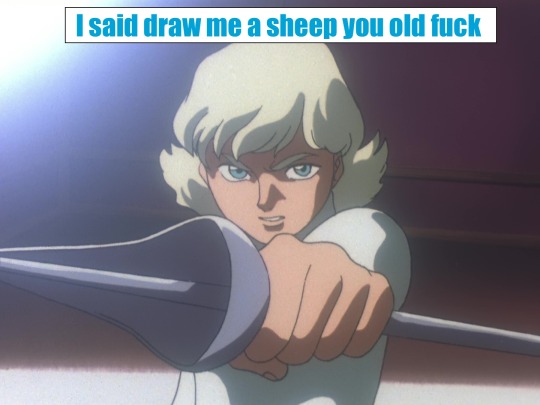
I am so delighted to report that the phrase Relena uses in episode 2-- "Does that mean Heero is a... Little Prince?" (or "Star Prince" in Japanese)-- is exactly what it seems to be:
It’s a reference to "The Little Prince", by Antoine de Saint-Exupéry.
More specifically, it’s from one of the backstories in “Episode Zero”– giving you yet another reason to read this important supplementary manga! It’s also featured in the new manga adaptation of GW, “Glory Of Losers”, which is excellent.
--Saint-Exupéry was himself an aristocrat by birth, and a notable pilot. He flew both as a pioneer of international postal flights, and as a fighter for the liberation of occupied France in WWII. He was shot down on a reconnaissance mission, flying his P-38 Lightning over the Mediterranean, and disappeared without confirmation of a wreck or his death. He was presumed missing in action until in the final years of the 20th century, when a silver bracelet with his identifiers was discovered off the coast of Marseilles .
Fun fact: if you read “The Little Prince” with Gundam Wing in mind, you will experience Several emotions!

--Once upon a time, Relena Darlain encountered a lovely, somber young man who came from the sky and rescued her from danger. She did not trust him, because he had come in a Mobile Suit, a machine of war and death. He called her “princess”, almost without thinking, as if it were the natural thing to call her– this was terribly confusing, for she was certain she was not a princess of any kind. Thinking the young man was simply being whimsical, she asked whether that made him a knight, or a dragon? He looked distant for a moment, as if conflicted by something weighing heavily upon him, but then gave a response suiting the theme of the moment, saying “I’m a prince from the stars”. The somber young man was indeed a little prince, who you might imagine came from a very small kingdom– home to a beautiful rose that was as fearless as she was helpless, with only little thorns to protect her that would not even deter a hungry sheep. He had run away from the responsibilities of this kingdom, and now could not return. When he’d first come to earth, he met a fox, who told him the only way to truly understand things was to tame them, and that one was responsible forever for the things that one tamed. The fox had said only that which was intangible really mattered. This had made him appreciate and love his rose even more, though she was far beyond his reach now, and the intangible goals he sought would only take him farther away. Years later, the girl Relena Darlain met another somber young man who had fallen from the sky as a shooting star– he was fierce and wild and not at all like the little prince she had met when she was a child. But he had come from the stars all the same, and something about him reminded her of that first encounter, and of the children's book of the same name. They were both hurt, and lost, and very alone. She said this thought aloud to herself dreamily, because at that moment she was still a child, though she wouldn’t be for very much longer.
—
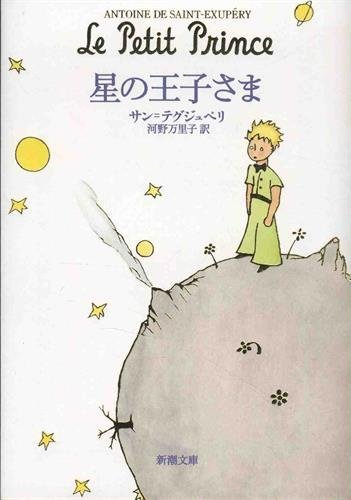
–The title of the Japanese translation of Le Petit Prince is “Hoshi no ouji sama”-- the subtitles for this in the anime read “Star Prince”, which is correct for Japan, and in the dub it is “Little Prince”, which is correct for the English title. This is a lovely bit of translation synchrony that doesn’t help one single bit in understanding what Relena means when she says this! But that is why we have Episode Zero, and if you really need proof that this is indeed a reference to the childrens’ book, I believe Sumisawa brings it up explicitly in Frozen Teardrop.
Gundam Wing is chock FULL of references to western lit and film– Wizard of OZ, White Fang, Lawrence of Arabia, Roman Holiday; “Darlain” is close enough to “Darling” that I suspect it’s a Peter Pan reference, and even Lady Une’s name is likely a reference to My Fair Lady, due to a very early scrapped idea for her character where she was a sort of clumsy, provincial girl that Treize was teaching to be “elegant”-- an element that stayed on in the series, albeit in a MUCH different context from Henry Higgins / Eliza Doolittle, thank god.
“Come on Gundam, move your bloomin’ arse!”
#parsing post#Gundam Wing#Milliardo Peacecraft#Relena Peacecraft#Heero Yuy#Wing Watcher's Toolkit#Gundam Wingtionary#tinyozlion pgw
36 notes
·
View notes